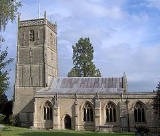
List of towers in Somerset
Encyclopedia
The Somerset towers
, church towers built in the 14th to 16th centuries, have been described as among England's finest contributions to medieval art. The paragraphs and descriptions below describe features of some of these towers. The organization follows Peter Poyntz-Wright's scheme for grouping the towers by what he understands to be roughly the date and group of mason-architects who built them. Poyntz-Wright's scheme came under criticism in the 1980s.
, shortly before 1390; Brent Knoll, about 1397; Mark
, about 1407; Weare
, about 1407; Banwell
, about 1417; Cheddar
, about 1423; and Winscombe
, around 1435.)
, about 1423; Cranmore
, about 1440; Mells
, 1446; Bruton
, about 1456; and Leigh-on-Mendip
, about 1464)
and Chew Magna
, about 1437; Kilmersdon
, about 1443; Dundry
, 1448 or earlier; Batheaston
, about 1458; Publow
, about 1467; Wellow
, about 1475; and Yeovil
St. John the Baptist, around 1480)
, about 1449; Wells
St. Cuthbert, about 1456; and Evercreech
, about 1462) -- window or bell-opening panels rise through several stages, emphasizing the towers' verticality.
, about 1455; Long Sutton
, about 1462; Westonzoyland
, about 1470; Muchelney
, possibly 1468)
, around 1477; Norton Sub Hamdon
, around 1485; and Hinton St George
, around 1492)
and Middlezoy
(combining Langport, Cheddar and Mendip features with new features) and Taunton St. James and Bishops Lydeard (which initiate a West Somerset ground plan)
, about 1507; Hatch Beauchamp
, about 1509; Staple Fitzpaine
, perhaps 1513; Isle Abbots
, about 1517; Huish Episcopi
, about 1524)
, about 1508; Wellington
about 1510; and Kingsbury Episcopi
, about 1515)
, around 1491; Mudford
, about 1498; Kingsdon
, about 1505; Martock
, about 1511; Chard
1520, but possibly earlier; and Charlton Horethorne
, about 1523.
, about 1400; Wedmore
base around 1400 and parapet about 1540; Yatton
, around 1400; Dunster
, 1442; Crewkerne
, about 1480; Ilminster
1500 to 1525.
at around 1468; Chew Stoke
about 1475; West Pennard
at about 1482; Charlton Musgrove
at perhaps around 1490; Pylle
at about 1497; Cloford after 1500. He also pegs three of the smaller towers in the western part of Somerset: Combe Florey
about 1499; Fivehead
, around 1505; and Langford Budville
, 1509. The end of the Perpendicular period in architecture coincides with construction of Ruishton
, 1533; Chedzoy
, 1539; and Batcombe
and Chewton Mendip
, around 1540.
Somerset towers
The Somerset towers are a collection of distinctive, mostly spireless Gothic church towers in the county of Somerset in south west England.Where beautiful castles and church spires rise above other parts of England, the crowning glory of many Somerset towns and villages is these medieval church...
, church towers built in the 14th to 16th centuries, have been described as among England's finest contributions to medieval art. The paragraphs and descriptions below describe features of some of these towers. The organization follows Peter Poyntz-Wright's scheme for grouping the towers by what he understands to be roughly the date and group of mason-architects who built them. Poyntz-Wright's scheme came under criticism in the 1980s.
Churchill generation
These churches have smaller towers with a single window in each face of the top stage; a pierced top parapet without merlons and four square-set corner pinnacles above.| Name of church | Photograph | Listed building grade | Year tower built | Height | Location | Description | Ref(s) |
|---|---|---|---|---|---|---|---|
| St John the Baptist Church of St John the Baptist, Churchill The Church of St John the Baptist in Churchill, Somerset, England, was largely built around 1360 and is a Grade I listed building.There was a Norman chapel on this site in 1180, from which the nave has survived into the present church.... |
 |
c. 1360 OR after 1420 | Churchill Churchill, Somerset Churchill is a village and civil parish in Somerset, England. It is located in the unitary authority of North Somerset, on the western edge of the Mendip Hills about east of Weston-super-Mare... 51.3342°N 2.8001°W |
The church was built around 1360. The tower has three stages with diagonal buttresses, moulded string courses, north-east polygonal higher corner stair turret with blind panelled embattled cap and pierced quatrefoil Quatrefoil The word quatrefoil etymologically means "four leaves", and applies to general four-lobed shapes in various contexts.-In heraldry:In heraldic terminology, a quatrefoil is a representation of a flower with four petals, or a leaf with four leaflets . It is sometimes shown "slipped", i.e. with an... lozenge parapet with corner pinnacles and gargoyles. |
|||
| Church of St Michael the Archangel Church of St Michael the Archangel, Compton Martin The Parish church of St Michael the Archangel is in the village of Compton Martin, Somerset, England.The church, which was built in the 12th century in a Norman style. Norman vaulting can be seen in the chancel and Jacobean work in choir stalls and organ screen. In the north wall is a recess... |
c. 1370 OR 1443 | 70 feet (21 m) | Compton Martin Compton Martin Compton Martin is a small village and civil parish within the Chew Valley in Somerset and civil parish in the Bath and North East Somerset unitary authority in England. The parish has a population of 508... 51.310281°N 2.654161°W |
Built around 1370 in a Norman Norman architecture About|Romanesque architecture, primarily English|other buildings in Normandy|Architecture of Normandy.File:Durham Cathedral. Nave by James Valentine c.1890.jpg|thumb|200px|The nave of Durham Cathedral demonstrates the characteristic round arched style, though use of shallow pointed arches above the... style. It is dedicated to St Michael the Archangel Michael (archangel) Michael , Micha'el or Mîkhā'ēl; , Mikhaḗl; or Míchaël; , Mīkhā'īl) is an archangel in Jewish, Christian, and Islamic teachings. Roman Catholics, Anglicans, and Lutherans refer to him as Saint Michael the Archangel and also simply as Saint Michael... . Norman vaulting can be seen in the chancel and Jacobean Jacobean era The Jacobean era refers to the period in English and Scottish history that coincides with the reign of King James VI of Scotland, who also inherited the crown of England in 1603 as James I... work in choir stalls and organ screen. The tower is approached from the nave via a lofty Tudor Tudor style architecture The Tudor architectural style is the final development of medieval architecture during the Tudor period and even beyond, for conservative college patrons... paneled arch. It contains six 18th century bells, five of which were cast by the Bilbies Bilbie family The Bilbie family were bell founders and clockmakers based initially in Chew Stoke, Somerset and later at Cullompton, Devon in south-west England from the late 17th century to the early 19th century.... of Chew Stoke Chew Stoke Chew Stoke is a small village and civil parish in the Chew Valley, in Somerset, England, about south of Bristol. It is at the northern edge of the Mendip Hills, a region designated by the United Kingdom as an Area of Outstanding Natural Beauty, and is within the Bristol/Bath green belt... . In the north wall is a recess containing the effigy of Thomas de Moreton which was discovered in 1858. One of the columns in the South side of the nave has an unusual spiral fluted decoration known as an apprentices column. Above the ceiling of the Bickfield Chapel there is a void which contains a columbarium Columbarium A columbarium is a place for the respectful and usually public storage of cinerary urns . The term comes from the Latin columba and originally referred to compartmentalized housing for doves and pigeons .The Columbarium of Pomponius Hylas is a particularly fine ancient Roman example, rich in... or dovecote. This housed 140 “squabs” or pigeons in 1606 for the rector’s table. |
|||
| Church of St Andrew Church of St Andrew, Compton Bishop The Church of St Andrewin Compton Bishop, Somerset, England dates from the 13th century, being consecrated by Bishop Jocelin in 1236, with more recent restoration. It is a Grade I listed building.... |
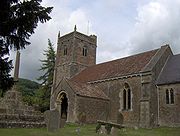 |
c. 1380 | Compton Bishop Compton Bishop Compton Bishop is a small village and civil parish, at the western end of the Mendip Hills in the English county of Somerset. It is located close to the historic town of Axbridge... 51.2945°N 2.8676°W |
The church dates from the 12th century, being consecrated by Bishop Jocelin Jocelin of Wells Jocelin of Wells, also known as Jocelinus Thoteman or Jocelin Troteman, was a medieval Bishop of Bath and Wells. He was the brother of Hugh de Wells, who became Bishop of Lincoln. Jocelin became a canon of Wells Cathedral before 1200, and was elected bishop in 1206... in 1236, with more recent restoration in 1370. It has a 15th century pulpit with tracery panels, carved friezes and cresting. Above the pulpit is a large pedimented wall monument to John Prowse who died in 1688, as well as several of his children. |
|||
| St Paul's Church of St Paul, Kewstoke The Church of St Paul in Kewstoke, Somerset, England dates from the 12th century with the tower being built in 1395. It has been designated as a Grade I listed building.... |
c. 1395 | Kewstoke Kewstoke Kewstoke is a civil parish and village in Somerset, England, within the unitary authority of North Somerset, located next to the strip of coast called Sand Bay... 51.3655°N 2.957°W |
The church dates from the 12th century. The tower is in two stages, with rendered, diagonal buttresses with setbacks which rise through the parapet as corner pinnacles. A polygonal stair turret at the south east corner rises to a pyramidal cap. The first stage has two, 2-light perpendicular west windows under a plain drip mould, and a similar but smaller window with carved stops to the south. The second stage has one 2-light perpendicular window under a drip mould with carved stops on each side; all are louvres Louver A louver or louvre , from the French l'ouvert; "the open one") is a window, blind or shutter with horizontal slats that are angled to admit light and air, but to keep out rain, direct sunshine, and noise... except the west which is blank. A quatrefoil pierced parapet has gargoyles at the corner. |
Cheddar generation
These churches have three windows in each face of the top stage; diagonal buttressing; some with squareset corner pinnacles; some with buttress pinnacles. These range from simple to elaborate designs: (BleadonBleadon
Bleadon is a village and civil parish in the historic countyof Somerset, England. It is about south of Weston-super-Mare and, according to the 2001 census, has a population of 1,068.-History:...
, shortly before 1390; Brent Knoll, about 1397; Mark
Mark, Somerset
Mark is a village and civil parish which lies approximately from Bridgwater, from Axbridge, and from Highbridge in the Sedgemoor district of the county of Somerset, England...
, about 1407; Weare
Weare, Somerset
Weare and Lower Weare are small villages in Somerset, England, on the River Axe, south of the Mendip Hills. The parish comprises the villages of Upper and Lower Weare, and the hamlets of Alston Sutton, Brinscombe and Stone Allerton....
, about 1407; Banwell
Banwell
Banwell is a village and civil parish on the River Banwell in the North Somerset district of Somerset, England. Its population was 2,923 according to the 2001 census.-History:...
, about 1417; Cheddar
Cheddar
Cheddar is a large village and civil parish in the Sedgemoor district of the English county of Somerset. It is situated on the southern edge of the Mendip Hills, north-west of Wells. The civil parish includes the hamlets of Nyland and Bradley Cross...
, about 1423; and Winscombe
Winscombe
Winscombe is a village in North Somerset, England, close to the settlements of Axbridge and Cheddar, on the western edge of the Mendip Hills, south-east of Weston-super-Mare and south-west of Bristol...
, around 1435.)
| Name of church | Photograph | Listed building grade | Year tower built | Height | Location | Description | Ref(s) |
|---|---|---|---|---|---|---|---|
| Church of St Andrew Church of St Andrew, Banwell The mainly 15th-century parish Church of St Andrew in Banwell, Somerset, England is a Grade I listed building.The body of the church has a nave with a clerestory, north and south aisles and a rather short chancel, considering the proportions of the rest of the church... |
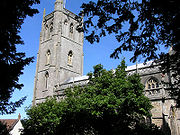 |
c. 1417 | 100 feet (30 m) | Banwell Banwell Banwell is a village and civil parish on the River Banwell in the North Somerset district of Somerset, England. Its population was 2,923 according to the 2001 census.-History:... 51.3279°N 2.8633°W |
The mainly 15th century church includes a nave Nave In Romanesque and Gothic Christian abbey, cathedral basilica and church architecture, the nave is the central approach to the high altar, the main body of the church. "Nave" was probably suggested by the keel shape of its vaulting... with a clerestory Clerestory Clerestory is an architectural term that historically denoted an upper level of a Roman basilica or of the nave of a Romanesque or Gothic church, the walls of which rise above the rooflines of the lower aisles and are pierced with windows. In modern usage, clerestory refers to any high windows... , north and south aisles and, a rather short chancel considering the proportions of the rest of the church. The high tower that contains 10 bells Church bell A church bell is a bell which is rung in a church either to signify the hour or the time for worshippers to go to church, perhaps to attend a wedding, funeral, or other service... dating from the 18th to 20th century and a clock dated 1884. Bells dating from 1734 and 1742 were made by Thomas Bilbie, of the Bilbie family Bilbie family The Bilbie family were bell founders and clockmakers based initially in Chew Stoke, Somerset and later at Cullompton, Devon in south-west England from the late 17th century to the early 19th century.... . |
||
| Church of St. Peter and St. Paul Church of St Peter & St Paul, Bleadon The Church of St Peter and St Paul dominates the village of Bleadon, Somerset, England.It was built in the 14th century , being restored and the chancel shortened in the mid 19th century... |
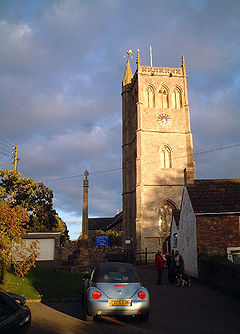 |
c. 1390 | Bleadon Bleadon Bleadon is a village and civil parish in the historic countyof Somerset, England. It is about south of Weston-super-Mare and, according to the 2001 census, has a population of 1,068.-History:... 51.3075°N 2.9462°W |
It was built in the 14th century (dedicated in 1317), being restored and the chancel shortened in the mid 19th century. The tower contains five bells dating from 1711 and made by Edward Bilbie of the Bilbie family Bilbie family The Bilbie family were bell founders and clockmakers based initially in Chew Stoke, Somerset and later at Cullompton, Devon in south-west England from the late 17th century to the early 19th century.... . |
|||
| Church of St Michael Church of St Michael, Brent Knoll The Church of St Michael at Brent Knoll, Somerset, England dates from the 11th century but has undergone several renovations since then. It has been designated as a grade I listed building.... |
 |
c. 1397 | Brent Knoll 51.252°N 2.9539°W |
The church dates back to the 11th century but has undergone several renovations since then. The tower contains a bell dating from 1777 and made by William Bilbie of the Bilbie family Bilbie family The Bilbie family were bell founders and clockmakers based initially in Chew Stoke, Somerset and later at Cullompton, Devon in south-west England from the late 17th century to the early 19th century.... . |
|||
| Church of St Andrew Church of St Andrew, Cheddar The Church of St Andrew in Cheddar, Somerset, England dates from the 14th century and has been designated as a Grade I listed building.The church was restored in 1873 by William Butterfield. It contains some 15th-century stained glass and an altar table of 1631... |
 |
c. 1423 | 100 feet (30 m) | Cheddar Cheddar Cheddar is a large village and civil parish in the Sedgemoor district of the English county of Somerset. It is situated on the southern edge of the Mendip Hills, north-west of Wells. The civil parish includes the hamlets of Nyland and Bradley Cross... 51.2737°N 2.7761°W |
The church dates from the 14th century. It was restored in 1873 by William Butterfield William Butterfield William Butterfield was a Gothic Revival architect and associated with the Oxford Movement . He is noted for his use of polychromy-Biography:... . It contains some 15th century stained glass Stained glass The term stained glass can refer to coloured glass as a material or to works produced from it. Throughout its thousand-year history, the term has been applied almost exclusively to the windows of churches and other significant buildings... and an altar table of 1631. The chest tomb Church monument A church monument is an architectural or sculptural memorial to a dead person or persons, located within a Christian church. It can take various forms, from a simple wall tablet to a large and elaborate structure which may include an effigy of the deceased person and other figures of familial or... in the chancel is believed to be to Sir Thomas Cheddar and dated 1442. The tower contains a bell dating from 1759 and made by Thomas Bilbie of the Bilbie family Bilbie family The Bilbie family were bell founders and clockmakers based initially in Chew Stoke, Somerset and later at Cullompton, Devon in south-west England from the late 17th century to the early 19th century.... . |
||
| Church of St Mark Church of St Mark, Mark The Church of St Mark in Mark, Somerset, England dates from the 13th century, but is mainly a 14th and 15th century building with further restoration in 1864... |
 |
c. 1407 | Mark Mark, Somerset Mark is a village and civil parish which lies approximately from Bridgwater, from Axbridge, and from Highbridge in the Sedgemoor district of the county of Somerset, England... 51.2262°N 2.8883°W |
The Church of St Mark (or Holy Cross) dates from the 13th century, but is mainly 14th and 15th century, with further restoration in 1864. | |||
| Church of St Gregory Church of St Gregory, Weare The Church of St Gregory in Weare, Somerset, England dates from the 11th century, although most of the building is from the 15th, and has been designated as a grade I listed building.The tower was built around 1407... |
 |
c. 1407 | Weare Weare, Somerset Weare and Lower Weare are small villages in Somerset, England, on the River Axe, south of the Mendip Hills. The parish comprises the villages of Upper and Lower Weare, and the hamlets of Alston Sutton, Brinscombe and Stone Allerton.... 51.2702°N 2.8413°W |
Dates from the 11th century. In the churchyard is a 15th century cross, and a 19th century church room. In 1257 the church was granted to St Augustine's Abbey in Bristol Bristol Bristol is a city, unitary authority area and ceremonial county in South West England, with an estimated population of 433,100 for the unitary authority in 2009, and a surrounding Larger Urban Zone with an estimated 1,070,000 residents in 2007... and after the dissolution of the monasteries Dissolution of the Monasteries The Dissolution of the Monasteries, sometimes referred to as the Suppression of the Monasteries, was the set of administrative and legal processes between 1536 and 1541 by which Henry VIII disbanded monasteries, priories, convents and friaries in England, Wales and Ireland; appropriated their... given to the dean and chapter of Bristol Cathedral Bristol Cathedral The Cathedral Church of the Holy and Undivided Trinity is the Church of England cathedral in the city of Bristol, England, and is commonly known as Bristol Cathedral... . |
|||
| Church of St James Church of St James, Winscombe The Church of St James in Winscombe, Somerset, England has 12th or 13th century origins but the present building dates from the 15th century. It is designated as a Grade I listed building.... |
 |
c. 1435 | 100 feet (30.5 m) | Winscombe Winscombe Winscombe is a village in North Somerset, England, close to the settlements of Axbridge and Cheddar, on the western edge of the Mendip Hills, south-east of Weston-super-Mare and south-west of Bristol... 51.3116°N 2.8342°W |
The church has 12th or 13th century origins but the present building dates from the 15th century. There are no records remaining of the Norman Norman architecture About|Romanesque architecture, primarily English|other buildings in Normandy|Architecture of Normandy.File:Durham Cathedral. Nave by James Valentine c.1890.jpg|thumb|200px|The nave of Durham Cathedral demonstrates the characteristic round arched style, though use of shallow pointed arches above the... church on the site, but there evidence of the building of the church which was consecrated by Bishop Jocelin Jocelin of Wells Jocelin of Wells, also known as Jocelinus Thoteman or Jocelin Troteman, was a medieval Bishop of Bath and Wells. He was the brother of Hugh de Wells, who became Bishop of Lincoln. Jocelin became a canon of Wells Cathedral before 1200, and was elected bishop in 1206... on 26 August 1236. The 4 stage tower was added in the early 15th century by Bishop John Harewell John Harewell John Harewell was a Roman Catholic Bishop of Bath and Wells in medieval England.Harewell came from Harwell in Berkshire . He was in the employ of the Black Prince before being selected, on 14 December 1366, as Bishop of Bath and Wells. He was consecrated on 7 March 1367 and died around 16 July... , and at the same time stained glass Stained glass The term stained glass can refer to coloured glass as a material or to works produced from it. Throughout its thousand-year history, the term has been applied almost exclusively to the windows of churches and other significant buildings... was added. The church was restored and a new Chancel added in 1863. The bells of St James have long called people to worship, the original bells being cast in 1773 by local founders, the Bilbie family Bilbie family The Bilbie family were bell founders and clockmakers based initially in Chew Stoke, Somerset and later at Cullompton, Devon in south-west England from the late 17th century to the early 19th century.... . Two newer bells were added in 1903 by Taylors Founders. The eight bells are in the key of E flat and the tenor weighs 18-1-8 – 18 hundredweight Hundredweight The hundredweight or centum weight is a unit of mass defined in terms of the pound . The definition used in Britain differs from that used in North America. The two are distinguished by the terms long hundredweight and short hundredweight:* The long hundredweight is defined as 112 lb, which... , 1 quarter of a hundredweight and 8 lb (930 kg). |
Mendip generation
Continues with the triple windows, but with a heavier groundplan featuring heavier buttresses braced diagonally back onto their walls and across the corner; pinnacles diagonal to the tower plan: (Shepton MalletShepton Mallet
Shepton Mallet is a small rural town and civil parish in the Mendip district of Somerset in South West England. Situated approximately south of Bristol and east of Wells, the town is estimated to have a population of 9,700. It contains the administrative headquarters of Mendip District Council...
, about 1423; Cranmore
Cranmore, Somerset
Cranmore is a village and civil parish east of Shepton Mallet, in the Mendip district of Somerset, England. The parish includes the hamlets of Waterlip, East Cranmore and Dean where Dean farmhouse dates from the 17th century, as does The Old Smithy, just off the A361 which was originally two...
, about 1440; Mells
Mells, Somerset
Mells is a village and civil parish in Somerset, England, near the town of Frome.The parish includes the village of Vobster which had a coal mine of the same name on the Somerset coalfield and quarry, both of which are now disused. The old quarry is now used as a diving centre...
, 1446; Bruton
Bruton
Bruton is a town and civil parish in Somerset, England, situated on the River Brue seven miles south-east of Shepton Mallet, just south of Snakelake Hill and Coombe Hill, ten miles north-west of Gillingham and twelve miles south-west of Frome in the South Somerset district. The town has a...
, about 1456; and Leigh-on-Mendip
Leigh-on-Mendip
Leigh-on-Mendip or Leigh upon Mendip is a small village on the Mendip Hills in Somerset, England. It lies roughly equidistant from Frome, Radstock and Shepton Mallet at about from each town....
, about 1464)
| Name of church | Photograph | Listed building grade | Year tower built | Height | Location | Description | Ref(s) |
|---|---|---|---|---|---|---|---|
| Church of St Mary Church of St Mary, Bruton The Church of St Mary in Bruton, Somerset, England was built in the 14th century. It has been designated a Grade I listed building.The first church on the site was founded by Ine of Wessex in the 7th century, which grew into an Augustinian Bruton Abbey the remains of which can be seen next to the... |
 |
c. 1456 | Bruton Bruton Bruton is a town and civil parish in Somerset, England, situated on the River Brue seven miles south-east of Shepton Mallet, just south of Snakelake Hill and Coombe Hill, ten miles north-west of Gillingham and twelve miles south-west of Frome in the South Somerset district. The town has a... 51.111667°N 2.451944°W |
The Church of St Mary was built in the 14th century | |||
| Church of St Bartholomew Church of St Bartholomew, Cranmore The Anglican Church of St Bartholomew in Cranmore, Somerset, England dates from the 15th century and has been designated as a Grade I listed building.... |
 |
15th century | Cranmore Cranmore, Somerset Cranmore is a village and civil parish east of Shepton Mallet, in the Mendip district of Somerset, England. The parish includes the hamlets of Waterlip, East Cranmore and Dean where Dean farmhouse dates from the 17th century, as does The Old Smithy, just off the A361 which was originally two... 51.1882°N 2.4761°W |
Dates from the 15th century. It has a three-stage embattled tower, supported by buttress Buttress A buttress is an architectural structure built against or projecting from a wall which serves to support or reinforce the wall... es with corner pinnacle Pinnacle A pinnacle is an architectural ornament originally forming the cap or crown of a buttress or small turret, but afterwards used on parapets at the corners of towers and in many other situations. The pinnacle looks like a small spire... s, tracery Tracery In architecture, Tracery is the stonework elements that support the glass in a Gothic window. The term probably derives from the 'tracing floors' on which the complex patterns of late Gothic windows were laid out.-Plate tracery:... and gargoyle Gargoyle In architecture, a gargoyle is a carved stone grotesque, usually made of granite, with a spout designed to convey water from a roof and away from the side of a building thereby preventing rainwater from running down masonry walls and eroding the mortar between... s. There is a stone fan vault Fan vault thumb|right|250px|Fan vaulting over the nave at Bath Abbey, Bath, England. Made from local Bath stone, this is a [[Victorian restoration]] of the original roof of 1608.... under the tower. |
|||
| St Giles' church Church of St Giles, Leigh-on-Mendip The Church of St Giles in Leigh-on-Mendip, Somerset, England dates from around 1350, and was rebuilt around 1500.It is a Grade 1 listed building, with an unusual faceless clock.... |
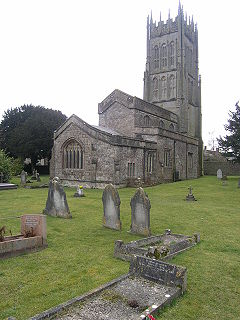 |
c. 1464 | Leigh-on-Mendip Leigh-on-Mendip Leigh-on-Mendip or Leigh upon Mendip is a small village on the Mendip Hills in Somerset, England. It lies roughly equidistant from Frome, Radstock and Shepton Mallet at about from each town.... 51.2239°N 2.4416°W |
Dates from the 15th century and has an unusual faceless clock. | |||
| St Andrew's Church |  |
1446 | 104 feet (32 m) | Mells Mells, Somerset Mells is a village and civil parish in Somerset, England, near the town of Frome.The parish includes the village of Vobster which had a coal mine of the same name on the Somerset coalfield and quarry, both of which are now disused. The old quarry is now used as a diving centre... 51.241928°N 2.390525°W |
The church is predominantly from the late 15th century. The centre of the chapel is dominated by an equestrian statue to Edward Horner who fell at the Battle of Cambrai in 1917 by Sir Alfred Munnings Alfred Munnings Sir Alfred James Munnings KCVO, PRA was known as one of England's finest painters of horses, and as an outspoken enemy of Modernism... . There is also a memorial, designed by Edwin Lutyens Edwin Lutyens Sir Edwin Landseer Lutyens, OM, KCIE, PRA, FRIBA was a British architect who is known for imaginatively adapting traditional architectural styles to the requirements of his era... , to Raymond Asquith Raymond Asquith Raymond Asquith was an English barrister and eldest son and heir of British Prime Minister H. H. Asquith by his first wife Helen Kelsall Melland .- Career and honours :... , who died in France France The French Republic , The French Republic , The French Republic , (commonly known as France , is a unitary semi-presidential republic in Western Europe with several overseas territories and islands located on other continents and in the Indian, Pacific, and Atlantic oceans. Metropolitan France... in 1916. The churchyard is the last resting place of the poet Siegfried Sassoon Siegfried Sassoon Siegfried Loraine Sassoon CBE MC was an English poet, author and soldier. Decorated for bravery on the Western Front, he became one of the leading poets of the First World War. His poetry both described the horrors of the trenches, and satirised the patriotic pretensions of those who, in Sassoon's... and the writer Ronald Knox Ronald Knox Ronald Arbuthnott Knox was an English priest, theologian and writer.-Life:Ronald Knox was born in Kibworth, Leicestershire, England into an Anglican family and was educated at Eton College, where he took the first scholarship in 1900 and Balliol College, Oxford, where again... , among other notables. |
||
| Church of St Peter and St Paul Church of St Peter and St Paul, Shepton Mallet The Church of St Peter and St Paul in Shepton Mallet, Somerset, England dates from the 12th century and has been designated as a Grade I listed building.... |
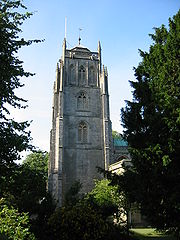 |
c. 1423 | Shepton Mallet Shepton Mallet Shepton Mallet is a small rural town and civil parish in the Mendip district of Somerset in South West England. Situated approximately south of Bristol and east of Wells, the town is estimated to have a population of 9,700. It contains the administrative headquarters of Mendip District Council... 51.191°N 2.5457°W |
Dates from the 12th century but the current building is largely from the 15th century, with further rebuilding in 1836. The timber roof includes 350 panels of different designs and 36 carved angels along the sides. |
Winford generation
These churches are contemporary with the Mendip Generation, but more akin to the Churchill group; conveying a sense of great height; single window per face in the top stage as well as lower stages; buttresses set back away from the corners and stepped at stage junctions and middles of stages; square-set pinnacles and most without merlons: (Portishead, about 1420; Backwell, possibly 1428; WinfordWinford
Winford is a small village and civil parish within the Chew Valley, Somerset, England. It is within the unitary authority of North Somerset about south of Bristol...
and Chew Magna
Chew Magna
Chew Magna is a village and civil parish within the Chew Valley in the Unitary Authority of Bath and North East Somerset, in the Ceremonial county of Somerset, England. The parish has a population of 1,161.To the south of the village is Chew Valley Lake...
, about 1437; Kilmersdon
Kilmersdon
Kilmersdon is a small village located in the north of Somerset between the towns of Radstock and Frome. The settlement is recorded in William I's Domesday book and dates back at least 1,000 years; though the core of the village dates from the mid nineteenth century.-History:The name Kilmersdon...
, about 1443; Dundry
Dundry
Dundry is a village and civil parish, situated on Dundry Hill in the northern part of the Mendip Hills, between Bristol and the Chew Valley Lake, in the English county of Somerset. The parish includes the hamlets of Maiden Head and East Dundry...
, 1448 or earlier; Batheaston
Batheaston
Batheaston is a village and civil parish east of Bath, England , on the north bank of the River Avon. The parish has a population of 2,625...
, about 1458; Publow
Publow
Publow is a small village in the civil parish of Publow and Pensford in Bath and North East Somerset, England. It lies beside the River Chew in the Chew Valley. It is 7 miles from Bristol, 9 miles from Bath, and 4 miles from Keynsham.- History :...
, about 1467; Wellow
Wellow, Somerset
Wellow is a village and civil parish in Somerset, England, about south of Bath. The parish, which includes the hamlet of Twinhoe has a population of 511...
, about 1475; and Yeovil
Yeovil
Yeovil is a town and civil parish in south Somerset, England. The parish had a population of 27,949 at the 2001 census, although the wider urban area had a population of 42,140...
St. John the Baptist, around 1480)
| Name of church | Photograph | Listed building grade | Year tower built | Height | Location | Description | Ref(s) |
|---|---|---|---|---|---|---|---|
| Church of St Andrew, Chew Magna Church of St Andrew, Chew Magna The Church of St Andrew in Chew Magna, Somerset, England dates from the 12th century with a large 15th-century pinnacled sandstone tower, a Norman font and a rood screen that is the full width of the church... |
c. 1440 | 100 feet (30.5 m) | Chew Magna Chew Magna Chew Magna is a village and civil parish within the Chew Valley in the Unitary Authority of Bath and North East Somerset, in the Ceremonial county of Somerset, England. The parish has a population of 1,161.To the south of the village is Chew Valley Lake... 51.366667°N 2.609722°W |
Dates from the 12th century with a large 15th-century pinnacled sandstone Sandstone Sandstone is a sedimentary rock composed mainly of sand-sized minerals or rock grains.Most sandstone is composed of quartz and/or feldspar because these are the most common minerals in the Earth's crust. Like sand, sandstone may be any colour, but the most common colours are tan, brown, yellow,... tower, a Norman Norman architecture About|Romanesque architecture, primarily English|other buildings in Normandy|Architecture of Normandy.File:Durham Cathedral. Nave by James Valentine c.1890.jpg|thumb|200px|The nave of Durham Cathedral demonstrates the characteristic round arched style, though use of shallow pointed arches above the... font Baptismal font A baptismal font is an article of church furniture or a fixture used for the baptism of children and adults.-Aspersion and affusion fonts:... and a rood screen Rood screen The rood screen is a common feature in late medieval church architecture. It is typically an ornate partition between the chancel and nave, of more or less open tracery constructed of wood, stone, or wrought iron... that is the full width of the church. There has been a clock on the tower since the early 1700s. There is a peal of eight bells Church bell A church bell is a bell which is rung in a church either to signify the hour or the time for worshippers to go to church, perhaps to attend a wedding, funeral, or other service... in the tower. Tenor 28cwt in C. The original five bells were re-cast by the celebrated Thomas Bilbie of Chew Stoke in 1735 to make a peal of six, and in 1898 four of these were re-cast and two were repaired by Messrs. Mears and Stainbank of London to commemorate the Diamond Jubilee Diamond Jubilee A Diamond Jubilee is a celebration held to mark a 60th anniversary in the case of a person or a 75th anniversary in the case of an event.- Thailand :... of Queen Victoria. Two additional bells, the gift of Brigadier Ommanney, were added in 1928 to complete the octave Octave In music, an octave is the interval between one musical pitch and another with half or double its frequency. The octave relationship is a natural phenomenon that has been referred to as the "basic miracle of music", the use of which is "common in most musical systems"... , which does still contain two of the Bilbie bells. The present clock Clock A clock is an instrument used to indicate, keep, and co-ordinate time. The word clock is derived ultimately from the Celtic words clagan and clocca meaning "bell". A silent instrument missing such a mechanism has traditionally been known as a timepiece... , installed in 1903, plays a verse of a hymn Hymn A hymn is a type of song, usually religious, specifically written for the purpose of praise, adoration or prayer, and typically addressed to a deity or deities, or to a prominent figure or personification... every four hours, at 8 am, noon, 4 and 8 pm, with a different hymn tune Hymn tune A hymn tune is the melody of a musical composition to which a hymn text is sung. Musically speaking, a hymn is generally understood to have four-part harmony, a fast harmonic rhythm , and no refrain or chorus.... for every day of the week. |
|||
| Church of St Michael Church of St Michael, Dundry The parish church of St Michael the Archangel in Dundry, Somerset, England has a tower which was built in 1484, with the rest dated 1861. It has been designated as a Grade I listed building.... |
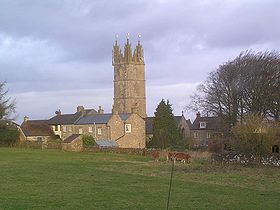 |
c. 1448 | Dundry Dundry Dundry is a village and civil parish, situated on Dundry Hill in the northern part of the Mendip Hills, between Bristol and the Chew Valley Lake, in the English county of Somerset. The parish includes the hamlets of Maiden Head and East Dundry... 51.399°N 2.6373°W |
A prominent feature in its hilltop position with its tower visible for many miles around. The tower was erected by the Society of Merchant Venturers of Bristol Bristol Bristol is a city, unitary authority area and ceremonial county in South West England, with an estimated population of 433,100 for the unitary authority in 2009, and a surrounding Larger Urban Zone with an estimated 1,070,000 residents in 2007... as a landmark and is visible from many parts of Avon Avon (county) Avon was, from 1974 to 1996, a non-metropolitan and ceremonial county in the west of England.The county was named after the River Avon, which runs through the area. It was formed from parts of the historic counties of Gloucestershire and Somerset, together with the City of Bristol... . |
|||
| Church of All Saints Church of All Saints, Publow The Church of All Saints in Publow, Somerset, England dates from the 14th century has a 15th-century tower with gargoyles. The pulpit is Jacobean. It has been designated a Grade I listed building.... |
c. 1467 | Publow Publow Publow is a small village in the civil parish of Publow and Pensford in Bath and North East Somerset, England. It lies beside the River Chew in the Chew Valley. It is 7 miles from Bristol, 9 miles from Bath, and 4 miles from Keynsham.- History :... 51.376111°N 2.542222°W |
Dates from the 14th century and has a tower with gargoyles. The pulpit is Jacobean. The church consists of a west tower, nave, north aisle and porch, south aisle and porch, and chancel. The west tower has 4 stages with set back buttresses terminating in diagonally set pinnacle Pinnacle A pinnacle is an architectural ornament originally forming the cap or crown of a buttress or small turret, but afterwards used on parapets at the corners of towers and in many other situations. The pinnacle looks like a small spire... s at the bell chamber stage. The nave Nave In Romanesque and Gothic Christian abbey, cathedral basilica and church architecture, the nave is the central approach to the high altar, the main body of the church. "Nave" was probably suggested by the keel shape of its vaulting... has a clerestorey of four 2-light trefoil Trefoil Trefoil is a graphic form composed of the outline of three overlapping rings used in architecture and Christian symbolism... headed windows. The east end of the chancel has an early perpendicular (restored) 3-light window with reticulated tracery. The pulpit dates from the early 17th century, and is made of oak Oak An oak is a tree or shrub in the genus Quercus , of which about 600 species exist. "Oak" may also appear in the names of species in related genera, notably Lithocarpus... with carved, arcaded panels to the upper part and rosettes on the lower part. |
||||
| Church St Peter and St Paul Church of St Peter and St Paul, Kilmersdon The Church of St Peter and St Paul in Kilmersdon, Somerset, England dates back to the Norman period, though much of the current structure was built during the 15th and 16th centuries and restored in the Victorian era... |
c. 1443 | Kilmersdon Kilmersdon Kilmersdon is a small village located in the north of Somerset between the towns of Radstock and Frome. The settlement is recorded in William I's Domesday book and dates back at least 1,000 years; though the core of the village dates from the mid nineteenth century.-History:The name Kilmersdon... 51.2702°N 2.437°W |
Dates back to the Norman Period, though much of the current structure was built during the Victorian era. The tower is in four stages, includes corner buttresses with shafts and pinnacles, and is connected across the angle. The summit has large corner shafts with pinnacles. There are traceried 3-light bell-chamber windows with a dense quatrefoil interlace and blank 2-light windows on the 2 lower stages. The flanked niches were for statuary, however this is now missing. The church has a triangular lychgate designed by Sir Edwin Lutyens. | ||||
| Church of St Julian Church of St Julian, Wellow The Church of St Julian in Wellow, Somerset, England has origins before the 12th century although the present building dates from 1372. It has been designated as a Grade I listed building.-History:... |
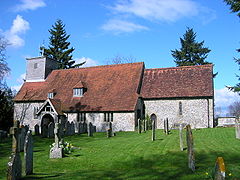 |
c. 1475 | Wellow Wellow, Somerset Wellow is a village and civil parish in Somerset, England, about south of Bath. The parish, which includes the hamlet of Twinhoe has a population of 511... 51.324444°N 2.3725°W |
The church is dedicated to St. Julian Julian of Antioch Saint Julian of Antioch is venerated as a Christian martyr of the fourth century. His date of death is given as 305 AD . He is sometimes confused with another saint of the same name.Of senatorial rank, he was killed during the persecutions of Diocletian... and has origins before the 12th century although the present building dates from 1372. The west tower has three stages, set back buttresses with off-sets which turn into diagonal pinnacles in upper stages. There is an embattled parapet with pinnacles. The square stair turret on the south-east corner terminates as an octagon. There is a 3-light window to the bell chamber with cusped heads and a similar but larger window with transom to west. |
|||
| Church of St John The Baptist Church of St John the Baptist, Yeovil The Church of St John the Baptist in Yeovil, Somerset, England was built in the late 14th century and has been designated as a Grade I listed building.... |
 |
c. 1480 | 92 feet (28 m) | Yeovil Yeovil Yeovil is a town and civil parish in south Somerset, England. The parish had a population of 27,949 at the 2001 census, although the wider urban area had a population of 42,140... 50.941667°N 2.631389°W |
Dates from the late 14th century. The tower is in 4-stages with set back offset corner buttresses. It is capped by openwork balustrading matching the parapets which are from the 19th century. There are two-light late 14th century windows on all sides at bell-ringing and bell-chamber levels, the latter having fine pierced stonework grilles. There is a stair turret to the north-west corner, with a Weather vane Weather vane A weather vane is an instrument for showing the direction of the wind. They are typically used as an architectural ornament to the highest point of a building.... termination. The tower contains two bells dating from 1728 and made by Thomas Bilbie. The "Great Bell" was recast from 4502 lb (2,042.1 kg; 321.6 st) to 4992 lb (2,264.3 kg; 356.6 st). |
||
| St John the Baptist with St Catherine | c. 1458 | Batheaston Batheaston Batheaston is a village and civil parish east of Bath, England , on the north bank of the River Avon. The parish has a population of 2,625... 51.4065°N 2.3112°W |
Built in the 12th century, and remodelled in the late 15th century. The west tower which has four stages with a pierced embattled parapet, setback buttresses, projecting octagonal stairs, and a turret at the south-east corner which terminates in spirelet, was rebuilt in 1834 by John Pinch the younger John Pinch the younger John Pinch the younger was an architect, working mainly in the city of Bath, England, and surveyor to the Pulteney and Darlington estate... of Bath. It has pointed perpendicular 2-light windows with cusped heads and the east side has a canopied niche containing a figure, probably St. John. |
||||
| Church of St. Mary and St. Peter Church of St Mary and St Peter, Winford The Church of St Mary and St Peter in Winford, Somerset, England dates from the 15th Century. It has been designated as a Grade II* listed building.... |
 |
c. 1437 | Winford Winford Winford is a small village and civil parish within the Chew Valley, Somerset, England. It is within the unitary authority of North Somerset about south of Bristol... 51.3825°N 2.658056°W |
Dates from the 15th Century. The 4-stage west tower has set back buttresses, moulded string courses and the north-east corner has a polygonal stair turret. Trefoil-headed open panel parapet with corner crocketted pinnacles and fine gargoyles. Top 3 stages have 2-light openings with hoodmoulds and lozenge stops, those below bell stage blind, those to bell stage louvred. 1st stage of west facade has deeply moulded pointed-arched doorway with 2-leaf doors and applied Gothick mouldings; light with intersecting tracery above. Above this a 3-light Gothick window. |
Long panel generation
This group (including WringtonWrington
Wrington is a village and civil parish in North Somerset, England. It lies in the valley of the Congresbury Yeo river about east of Weston-super-Mare and south-east of Yatton. It is both a civil parish, with a population of 2,896, and an ecclesiastical parish...
, about 1449; Wells
Wells
Wells is a cathedral city and civil parish in the Mendip district of Somerset, England, on the southern edge of the Mendip Hills. Although the population recorded in the 2001 census is 10,406, it has had city status since 1205...
St. Cuthbert, about 1456; and Evercreech
Evercreech
Evercreech is a village and civil parish south east of Shepton Mallet, and north east of Castle Cary, in the Mendip district of Somerset, England...
, about 1462) -- window or bell-opening panels rise through several stages, emphasizing the towers' verticality.
| Name of church | Photograph | Listed building grade | Year tower built | Height | Location | Description | Ref(s) |
|---|---|---|---|---|---|---|---|
| Church of St Peter Church of St Peter, Evercreech The Church of St Peter in Evercreech, Somerset, England dates from the 14th century and is a Grade I listed building.The three-stage tower has set-back buttresses ascending to pinnacles, with a very tall transomed two-light bell-chamber with windows on each face The embattled parapet has quatrefoil... |
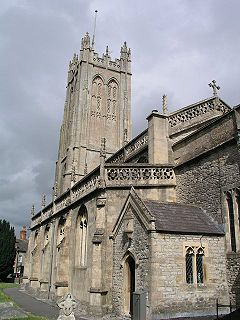 |
c. 1462 | Evercreech Evercreech Evercreech is a village and civil parish south east of Shepton Mallet, and north east of Castle Cary, in the Mendip district of Somerset, England... 51.1462°N 2.5027°W |
Dates from the 14th century. The three-stage tower has set-back buttresses ascending to pinnacles, with a very tall transomed 2-light bell-chamber with windows on each face The embattled parapet has quatrefoil piercing, with big corner pinnacles and smaller intermediate pinnacles. The 4-light west window has extensively restored tracery. This tower is of the East Mendip type. On the north wall of the tower is a roll of honour to the victims of World War I World War I World War I , which was predominantly called the World War or the Great War from its occurrence until 1939, and the First World War or World War I thereafter, was a major war centred in Europe that began on 28 July 1914 and lasted until 11 November 1918... . It is within a rectangular wooden case with a glazed door crowned by a triangular pediment and plaque below. |
|||
| Church of St. Cuthbert Church of St Cuthbert, Wells The Church of St Cuthbert is an Anglican parish church in Wells, Somerset, England dating from the 13th century. It is often mistaken for the cathedral. It has a fine Somerset stone tower and a superb carved roof. It is a Grade I listed building.... |
 |
c. 1456 OR 1561 | 142 feet (43 m) | Wells Wells Wells is a cathedral city and civil parish in the Mendip district of Somerset, England, on the southern edge of the Mendip Hills. Although the population recorded in the 2001 census is 10,406, it has had city status since 1205... 51.2068°N 2.6526°W |
Often mistaken for the cathedral Wells Cathedral Wells Cathedral is a Church of England cathedral in Wells, Somerset, England. It is the seat of the Bishop of Bath and Wells, who lives at the adjacent Bishop's Palace.... . It has a fine Somerset stone tower and a superb carved roof. Originally an Early English building (13th century), it was much altered in the Perpendicular period (15th century). The tower is the third highest in Somerset. is of 3 stages, with the top stage occupying half the total height. Until 1561 the church had a central tower which either collapsed or was removed, and has been replaced with the current tower over the west door. Bells were cast for the tower by Roger Purdy. |
||
| Church of All Saints Church of All Saints, Wrington The Church of All Saints in Wrington, Somerset, England has 13th-century foundations, and was remodelled with the addition of a west tower around 1450. It is a Grade I listed building.... |
 |
c. 1450 | 113.5 feet (35 m) | Wrington Wrington Wrington is a village and civil parish in North Somerset, England. It lies in the valley of the Congresbury Yeo river about east of Weston-super-Mare and south-east of Yatton. It is both a civil parish, with a population of 2,896, and an ecclesiastical parish... 51.361°N 2.7658°W |
The church has 13th century foundations, and was remodelled with the addition of a west tower around 1450. It was restored in 1859 with further restoration to the tower in 1948. It includes stone busts to John Locke John Locke John Locke FRS , widely known as the Father of Liberalism, was an English philosopher and physician regarded as one of the most influential of Enlightenment thinkers. Considered one of the first of the British empiricists, following the tradition of Francis Bacon, he is equally important to social... and Hannah More Hannah More Hannah More was an English religious writer, and philanthropist. She can be said to have made three reputations in the course of her long life: as a poet and playwright in the circle of Johnson, Reynolds and Garrick, as a writer on moral and religious subjects, and as a practical... dating from the early 19th century on either side of the door. The chancel Chancel In church architecture, the chancel is the space around the altar in the sanctuary at the liturgical east end of a traditional Christian church building... has gothic Gothic architecture Gothic architecture is a style of architecture that flourished during the high and late medieval period. It evolved from Romanesque architecture and was succeeded by Renaissance architecture.... reredos Reredos thumb|300px|right|An altar and reredos from [[St. Josaphat's Roman Catholic Church|St. Josaphat Catholic Church]] in [[Detroit]], [[Michigan]]. This would be called a [[retable]] in many other languages and countries.... by Charles Barry Charles Barry Sir Charles Barry FRS was an English architect, best known for his role in the rebuilding of the Palace of Westminster in London during the mid-19th century, but also responsible for numerous other buildings and gardens.- Background and training :Born on 23 May 1795 in Bridge Street, Westminster... dating from 1832. The rood screen is from the 16th century. It has a tall 4-stage tower with set-back buttresses which develop into crocket Crocket A crocket is a hook-shaped decorative element common in Gothic architecture. It is in the form of a stylised carving of curled leaves, buds or flowers which is used at regular intervals to decorate the sloping edges of spires, finials, pinnacles, and wimpergs.... ted pinnacles at the top stage. The top displays moulded string courses and a trefoil pierced triangular parapet with gargoyles and corner pinnacles. According to Freeman it is "one of the "highest achievements of architectural genius". Wickham it dates from the period 1420 to 1450. The belfry stair is in the south east turret. |
Langport generation
This group (including LangportLangport
Langport is a small town and civil parish in Somerset, England, situated west of Somerton in the South Somerset district. The town has a population of 1,067. The parish includes the hamlets of Bowdens and Combe...
, about 1455; Long Sutton
Long Sutton, Somerset
Long Sutton is a village and civil parish in Somerset, England, situated south of Somerton in the South Somerset district. The village has a population of 862....
, about 1462; Westonzoyland
Westonzoyland
Westonzoyland is a village and civil parish in Somerset, England. It is situated on the Somerset Levels, south east of Bridgwater.-History:The name of the parish derives from its location on the "island" of Sowy, an area of slightly higher ground on the Somerset Levels between the River Cary and...
, about 1470; Muchelney
Muchelney
Muchelney is a village and civil parish in Somerset, England, on the River Parrett, south of Huish Episcopi and miles south west of Somerton in the South Somerset district...
, possibly 1468)
| Name of church | Photograph | Listed building grade | Year tower built | Height | Location | Description | Ref(s) |
|---|---|---|---|---|---|---|---|
| Church of All Saints Church of All Saints, Langport The Church of All Saints in Langport, Somerset, England, has 12th -century origins but was rebuilt in the late 15th century. It has been designated by English Heritage as a Grade I listed building.... |
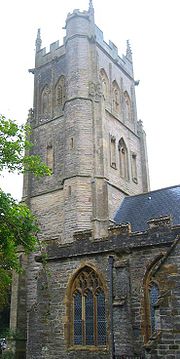 |
c. 1455 | Langport Langport Langport is a small town and civil parish in Somerset, England, situated west of Somerton in the South Somerset district. The town has a population of 1,067. The parish includes the hamlets of Bowdens and Combe... 51.037222°N 2.825556°W |
The in has 12th or 13th century origins. The square tower (with an octagonal stair-turret), which is in three stages, dates from the 15th century, although the top section was rebuilt in 1833. It has a number of interesting gargoyles known locally as ‘hunky punks’. The church is no longer used for services and is in the care of the Churches Conservation Trust Churches Conservation Trust The Churches Conservation Trust, which was initially known as the Redundant Churches Fund, is a charity whose purpose is to protect historic churches at risk, those that have been made redundant by the Church of England. The Trust was established by the Pastoral Measure of 1968... who have carried out extensive rebuilding work. |
|||
| Church of the Holy Trinity Church of the Holy Trinity, Long Sutton The Church of the Holy Trinity in Long Sutton, Somerset, England dates from the 15th century and has been designated as a Grade I listed building.... |
 |
c. 1462 | Long Sutton Long Sutton, Somerset Long Sutton is a village and civil parish in Somerset, England, situated south of Somerton in the South Somerset district. The village has a population of 862.... 51.032778°N 2.756389°W |
Dates from 1493. An earlier church would have stood on this site from the 9th century or earlier. The current church was built of local lias Early Jurassic The Early Jurassic epoch is the earliest of three epochs of the Jurassic period... stone cut and squared, with Ham stone dressings. It has stone slate roofs between stepped coped gabled with finial Finial The finial is an architectural device, typically carved in stone and employed decoratively to emphasize the apex of a gable or any of various distinctive ornaments at the top, end, or corner of a building or structure. Smaller finials can be used as a decorative ornament on the ends of curtain rods... s to the chancel Chancel In church architecture, the chancel is the space around the altar in the sanctuary at the liturgical east end of a traditional Christian church building... and north porch. Internally, the chancel has a ceiled wagon-roof, with moulded ribs and plaster panels. The tower exhibits the tracery typical of Somerset churches. The under-tower space has a lierne vault Lierne (vault) A Lierne in Gothic rib vaulting is an architectural term for a tertiary rib spanning between two other ribs, instead of from a springer, or to the central boss... , and a 15th century octagonal font Baptismal font A baptismal font is an article of church furniture or a fixture used for the baptism of children and adults.-Aspersion and affusion fonts:... with quatrefoil panels. The tower has a ring of six bells, the tenor weighing 136 stones (864 kg). |
|||
| Church of St Peter and St Paul Church of St Peter and St Paul, Muchelney The Church of St Peter and St Paul in Muchelney, Somerset, England has Saxon origins, however the current building largely dates from the 15th century... |
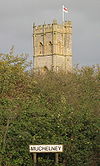 |
c. 1468 | Muchelney Muchelney Muchelney is a village and civil parish in Somerset, England, on the River Parrett, south of Huish Episcopi and miles south west of Somerton in the South Somerset district... 51.020556°N 2.815°W |
St. Peter and St. Paul parish church, adjacent to Muchelney Abbey Muchelney Abbey Muchelney Abbey is an English Heritage property in the village of Muchelney in the Somerset Levels, England.It comprises the remains and foundations of a medieval Benedictine abbey, the site of an earlier Anglo-Saxon abbey, and an early Tudor house dating from the 16th century, formerly the... , has a ceiling enlivened with Jacobean Jacobean era The Jacobean era refers to the period in English and Scottish history that coincides with the reign of King James VI of Scotland, who also inherited the crown of England in 1603 as James I... paintings of bare-breasted angels, their nudity thought to symbolize innocent purity. It has a 3-stage tower supported by pairs of full-height corner buttresses. The south east octagonal stair turret leads to an outer door. |
|||
| St Mary’s Parish Church Church of St Mary the Virgin, Westonzoyland The Church of St Mary the Virgin in Westonzoyland, Somerset, England dates from the 13th century and has been designated as a Grade I listed building.St Mary’s Parish Church, with its 15th-century carved timber roof, has a link with two conflicts... |
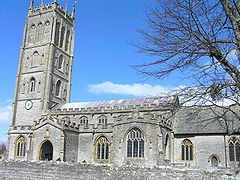 |
c. 1470 | Westonzoyland Westonzoyland Westonzoyland is a village and civil parish in Somerset, England. It is situated on the Somerset Levels, south east of Bridgwater.-History:The name of the parish derives from its location on the "island" of Sowy, an area of slightly higher ground on the Somerset Levels between the River Cary and... 51.1087°N 2.9264°W |
Has a 15th century carved timber roof, served as a prison after the 1685 Battle of Sedgemoor Battle of Sedgemoor The Battle of Sedgemoor was fought on 6 July 1685 and took place at Westonzoyland near Bridgwater in Somerset, England.It was the final battle of the Monmouth Rebellion and followed a series of skirmishes around south west England between the forces of James Scott, 1st Duke of Monmouth and the... . The 4 stage tower has an embattled parapet with quatrefoil arcading, and set-back buttresses which terminate in pinnacles on the bell-chamber stage. |
Shepton Beauchamp generation
On these churches, each face of the top stage bears a window panel extending down into the stage below: (including Shepton BeauchampShepton Beauchamp
Shepton Beauchamp is a village and civil parish, from Barrington and north east of Ilminster between the Blackdown Hills and the Somerset Levels in the South Somerset district of Somerset, England.-History:...
, around 1477; Norton Sub Hamdon
Norton Sub Hamdon
Norton sub Hamdon is a village in the South Somerset district of the English county of Somerset, situated five miles west of Yeovil. The village has a population of 694....
, around 1485; and Hinton St George
Hinton St George
Hinton St George is a village and parish in Somerset, England, situated outside of Crewkerne, south west of Yeovil in the South Somerset district. The village has a population of 404....
, around 1492)
| Name of church | Photograph | Listed building grade | Year tower built | Height | Location | Description | Ref(s) |
|---|---|---|---|---|---|---|---|
| St. Michael's church Church of St Michael, Shepton Beauchamp The Church of St Michael in Shepton Beauchamp, Somerset, England is built of local hamstone, and has 13th-century origins, although it has been extensively changed since then, with major renovation in 1865 by George Edmund Street... |
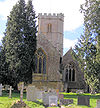 |
c. 1477 | Shepton Beauchamp Shepton Beauchamp Shepton Beauchamp is a village and civil parish, from Barrington and north east of Ilminster between the Blackdown Hills and the Somerset Levels in the South Somerset district of Somerset, England.-History:... 50.950278°N 2.849167°W |
Built of local Hamstone Hamstone Hamstone is the colloquial name given to stone from Ham Hill, Somerset, England. Hamstone is a Jurassic limestone from the Toarcian, or Upper Lias, stage. It is a well cemented medium to coarse grained limestone characterised by its honey-gold colour and marked bedding planes. The stone contains... , and has 13th century origins, although it has been extensively changed since then, with major renovation in 1865 by George Edmund Street George Edmund Street George Edmund Street was an English architect, born at Woodford in Essex.- Life :Street was the third son of Thomas Street, solicitor, by his second wife, Mary Anne Millington. George went to school at Mitcham in about 1830, and later to the Camberwell collegiate school, which he left in 1839... . It has a tall 3-stage tower with set-back buttresses ascending to the shafts of former pinnacles, set off with an embattled parapet and gargoyles. There are 2-light traceried bell-chamber windows with stone grilles, continuing as blank openings on the ringing chamber below. There are clocks with Roman numerals to the west and south faces and a higher polygonal stair-turret to the north corner. |
|||
| Church of St Mary the Virgin Church of St Mary the Virgin, Norton Sub Hamdon The Church of St Mary the Virgin in Norton Sub Hamdon, Somerset, England has 13th century origins but was rebuilt around 1510. It has been designated as a Grade I listed building.restoration was undertaken by Henry Wilson in 1894 and again in 1904.... |
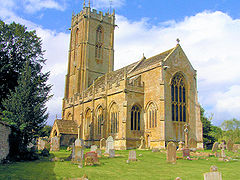 |
c. 1485 | 98.5 feet (30 m) | Norton Sub Hamdon Norton Sub Hamdon Norton sub Hamdon is a village in the South Somerset district of the English county of Somerset, situated five miles west of Yeovil. The village has a population of 694.... 50.94°N 2.753611°W |
Described as "An uncommonly perfect church" by Pevsner Pevsner Pevsner is a surname, and may refer to:* Antoine Pevsner , a Russian sculptor* Sir Nikolaus Pevsner , a German-born British scholar of the history of architecture;** .... it has 13th century origins, but was largely rebuilt between 1500 and 1510. Further restoration was undertaken by Henry Wilson in 1894 and 1904. The 5-stage tower was damaged by lightning and fire on 29 July 1894, but restored within a year preserving the original design. It has a double plinth, offset corner buttresses, dividing strings, battlemented parapet with pairs of corner pinnacles extended from buttresses, and central paired pinnacles with corbelled-off gargoyles. |
||
| Church of St George Church of St George, Hinton St George The Church of St George in Hinton St George, Somerset, England includes 13th-century work by masons of Wells Cathedral, and has been designated as a Grade I listed building.... |
 |
c. 1492 | Hinton St George Hinton St George Hinton St George is a village and parish in Somerset, England, situated outside of Crewkerne, south west of Yeovil in the South Somerset district. The village has a population of 404.... 50.910833°N 2.827222°W |
Includes 13th century work by masons of Wells Cathedral. The vestry and north chapel of 1814 are said to be by James Wyatt James Wyatt James Wyatt RA , was an English architect, a rival of Robert Adam in the neoclassical style, who far outdid Adam in his work in the neo-Gothic style.-Early classical career:... , however it is more likely to be by Jeffry Wyatt, (later Sir Jeffry Wyattville). The 4-stage tower is dated to 1485-95. It is supported by full-height offset corner buttresses, and has battlemented parapets with quatrefoil panels below merlons on the corner and intermediate pinnacles. The weathervane was added in 1756 by Thomas Bagley of Bridgwater Bridgwater Bridgwater is a market town and civil parish in Somerset, England. It is the administrative centre of the Sedgemoor district, and a major industrial centre. Bridgwater is located on the major communication routes through South West England... . There is a hexagonal south-east corner stair turret. Stage 2 has a small light on the north side and a statue niche on the south. All the faces on the two upper stages have 2-light, mullioned, transomed and traceried windows under pointed arched labels, with pierced stone baffles. The clockface is under the east window. During restoration work the parapet of the tower was examined and a stone was discovered with a carved date of 1731 which may suggest that the decorative parapet may have been added then. The tracery on the north side has been marked out but never cut. In general there is little sign of more than one phase of construction although repairs are evident. |
Developmental/experimental
LyngLyng, Somerset
Lyng is a civil parish in Somerset, England, comprising the villages of West Lyng and East Lyng and the hamlet of Bankland.-History:The name derives from the Old English hlenc, meaning hill....
and Middlezoy
Middlezoy
Middlezoy is a village and civil parish on the River Parrett as it crosses the Somerset Levels in the Sedgemoor district of Somerset, England.-History:...
(combining Langport, Cheddar and Mendip features with new features) and Taunton St. James and Bishops Lydeard (which initiate a West Somerset ground plan)
| Name of church | Photograph | Listed building grade | Year tower built | Height | Location | Description | Ref(s) |
|---|---|---|---|---|---|---|---|
| Church of St Mary Church of St Mary, Bishops Lydeard The Church of St Maryin Bishops Lydeard, Somerset, England dates from the 14th and 15th centuries and has been designated as a Grade I listed building.In 1860–62 the church was extended by one bay and a vestry, by Edward Jeboult of Taunton, added.... |
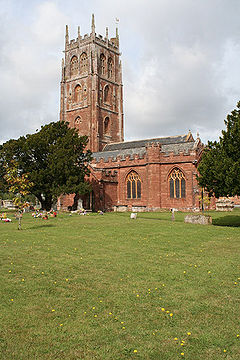 |
c. 1497 | Bishops Lydeard Bishops Lydeard Bishops Lydeard is a village and civil parish located in Somerset, England, bypassed, since 1967, by the A358 road and West Somerset Railway north-west of Taunton in the district of Taunton Deane... 51.0614°N 3.1872°W |
Dates from the 14th and 15th century and in 1860-62 was extended by one bay and a vestry by Jeboult of Taunton. The tower has pierced tracery battlements, pinnacles, set back buttresses terminating in pinnacles at the bell-storey, and pinnacles on the buttresses at each stage. | |||
| Church of St Bartholomew Church of St Bartholomew, Lyng The Church of St Bartholomew at East Lyng in the parish of Lyng, Somerset, England dates from the 14th century and has been designated as a Grade I listed building.... |
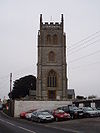 |
c. 1480 | East Lyng Lyng, Somerset Lyng is a civil parish in Somerset, England, comprising the villages of West Lyng and East Lyng and the hamlet of Bankland.-History:The name derives from the Old English hlenc, meaning hill.... 51.0553°N 2.9537°W |
Built by the monks who were displaced from Athelney Athelney Athelney is located between the villages of Burrowbridge and East Lyng in the Sedgemoor district of Somerset, England. The area is known as the Isle of Athelney, because it was once a very low isolated island in the 'very great swampy and impassable marshes' of the Somerset Levels. Much of the... Abbey Abbey An abbey is a Catholic monastery or convent, under the authority of an Abbot or an Abbess, who serves as the spiritual father or mother of the community.The term can also refer to an establishment which has long ceased to function as an abbey,... when it was dissolved by King Henry VIII of England Henry VIII of England Henry VIII was King of England from 21 April 1509 until his death. He was Lord, and later King, of Ireland, as well as continuing the nominal claim by the English monarchs to the Kingdom of France... in 1539. The ornate three-stage tower is of lias with Ham stone dressings supported by set-back buttresses connected diagonally across the angles of the tower on the bottom 2 stages, these terminate as diagonal pinnacles on shafts at the third stage. The paired 2-light bell-chamber windows have Somerset tracery flanked by attached shafts and pinnacles, with quatrefoil grilles. There are similar single windows on the stage below. |
|||
| Church of the Holy Cross Church of the Holy Cross, Middlezoy The Church of the Holy Cross in Middlezoy, Somerset, England dates from the 13th century and has been designated as a grade I listed building.... |
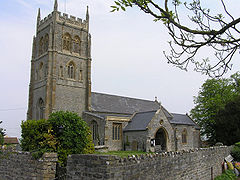 |
c. 1483 | Middlezoy Middlezoy Middlezoy is a village and civil parish on the River Parrett as it crosses the Somerset Levels in the Sedgemoor district of Somerset, England.-History:... 51.0939°N 2.8942°W |
3-stage tower similar to that at Lyng. | |||
| Church of St. James Church of St. James, Taunton The Church of the St. James in Taunton, Somerset, England dates from the early 14th century, although an earlier church was located on the same site in the 10th century. The church is dedicated to St. James the Greater... |
 |
c. 1491 | 111 feet (34 m) | Taunton Taunton Taunton is the county town of Somerset, England. The town, including its suburbs, had an estimated population of 61,400 in 2001. It is the largest town in the shire county of Somerset.... 51.0177°N 3.1013°W |
The oldest parts of St. James Church are early 14th Century and there are fragments of 15th Century glass in the West end. The sandstone tower was rebuilt in the 19th century.. The church backs onto the Somerset County Ground and forms a familiar backdrop to the popular Cricket ground. |
West Somerset generation
(Including Kingston St MaryKingston St Mary
Kingston St Mary is a village and parish in Somerset, England, situated at the southern end of the Quantock Hills north of Taunton in the Taunton Deane district...
, about 1507; Hatch Beauchamp
Hatch Beauchamp
Hatch Beauchamp is a village and civil parish in Somerset, England, situated south east of Taunton in the Taunton Deane district. The village has a population of 575.-History:...
, about 1509; Staple Fitzpaine
Staple Fitzpaine
Staple Fitzpaine is a village and civil parish in Somerset, England, situated south of Taunton in the Taunton Deane district. The village has a population of 151 and is within the Blackdown Hills Area of Outstanding Natural Beauty...
, perhaps 1513; Isle Abbots
Isle Abbots
Isle Abbots is a village and civil parish in Somerset, England, situated south east of Taunton in the South Somerset district...
, about 1517; Huish Episcopi
Huish Episcopi
Huish Episcopi is a village and civil parish in Somerset, England, situated on the outskirts of Langport, south west of Somerton in the South Somerset district...
, about 1524)
| Name of church | Photograph | Listed building grade | Year tower built | Height | Location | Description | Ref(s) |
|---|---|---|---|---|---|---|---|
| Church of St John the Baptist Church of St John the Baptist, Hatch Beauchamp The Church of St John the Baptist in Hatch Beauchamp, Somerset, England was built in the Norman period and has been designated as a Grade I listed building.... |
 |
c. 1509 | Hatch Beauchamp Hatch Beauchamp Hatch Beauchamp is a village and civil parish in Somerset, England, situated south east of Taunton in the Taunton Deane district. The village has a population of 575.-History:... 50.9856°N 2.9902°W |
A crenellated 3-stage tower. It displays crocketed pinnacles, a pierced parapet with quatrefoils and arcades in the merlons and gargoyles. This particular church has diagonal buttresses to support the tower whereas in other churches within this group angle buttresses are the norm.The buttresses, which finish in the belfry stage, support small detached shafts which rise upwards to form the outside subsidiary pinnacles of each corner cluster. | |||
| Church of the Blessed Virgin Mary Church of the Blessed Virgin Mary, Huish Episcopi The Church of the Blessed Virgin Mary in Huish Episcopi, Somerset, England has 12th century origins, but was largely rebuilt in 14th, 15th and 16th centuries. It has been designated as a Grade I listed building.St Mary's Church also serves nearby Langport... |
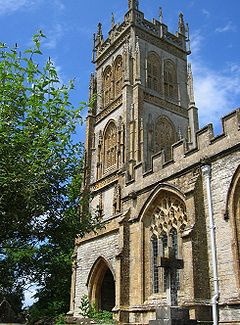 |
c. 1524 | 100 feet (30 m) | Huish Episcopi Huish Episcopi Huish Episcopi is a village and civil parish in Somerset, England, situated on the outskirts of Langport, south west of Somerton in the South Somerset district... 51.035833°N 2.818056°W |
12th century origins and also serves nearby Langport Langport Langport is a small town and civil parish in Somerset, England, situated west of Somerton in the South Somerset district. The town has a population of 1,067. The parish includes the hamlets of Bowdens and Combe... . Built in blue lias Blue Lias The Blue Lias is a geologic formation in southern, eastern and western England and parts of South Wales, part of the Lias Group. The Blue Lias consists of a sequence of limestone and shale layers, laid down in latest Triassic and early Jurassic times, between 195 and 200 million years ago... with golden hamstone Hamstone Hamstone is the colloquial name given to stone from Ham Hill, Somerset, England. Hamstone is a Jurassic limestone from the Toarcian, or Upper Lias, stage. It is a well cemented medium to coarse grained limestone characterised by its honey-gold colour and marked bedding planes. The stone contains... decoration, the church is most noted for its classic Somerset tower, deemed to be an architectural companion piece to St. Martin's church in Kingsbury Episcopi Kingsbury Episcopi Kingsbury Episcopi is a village and civil parish on the River Parrett in Somerset, England, situated north west of Yeovil in the South Somerset district. The village has a population of 1,277. The parish includes the villages of West Lambrook, East Lambrook and Thorney.-History:The "Episcopi"... . St Mary's tower dates from around 1500 and was built in 4 stages. It is extensively embellished with pinnacles and quatrefoil panel bands. In the north east corner is an octagonal stair turret which reaches the full height of the tower. The Huish Episcopi tower is depicted on the 9p Penny A penny is a coin or a type of currency used in several English-speaking countries. It is often the smallest denomination within a currency system.-Etymology:... stamp Postage stamp A postage stamp is a small piece of paper that is purchased and displayed on an item of mail as evidence of payment of postage. Typically, stamps are made from special paper, with a national designation and denomination on the face, and a gum adhesive on the reverse side... issued in June 1972. |
||
| Church of St. Mary the Virgin Church of St Mary the Virgin, Isle Abbotts The Church of St Mary the Virgin in Isle Abbotts, Somerset, England dates from the 13th century with several restorations since. It has been designated as a Grade I listed building.... |
 |
c. 1517 | Isle Abbots Isle Abbots Isle Abbots is a village and civil parish in Somerset, England, situated south east of Taunton in the South Somerset district... 50.983889°N 2.9225°W |
A tower of 4 stages. The embattled parapet is pierced by quatrefoils, the merlons pierced with lancet openings. The very large corner pinnacles have attached secondary pinnacles, and intermediate pinnacles to each side. The crocketted niches to each face of the tower have surviving medieval figures, to West the Risen Christ stepping from His sarcophagus, the Blessed Virgin with Bambino, St Peter and St Paul; to south St George, St Catherine, St Margaret; to east St John Baptist, St Clement; to north St Michael. The wealth of architectural detail and sculpture has required specific approaches to the methodology of repair and protection using lime based materials. | |||
| Church of St Mary Church of St Mary, Kingston St Mary The Church of St Mary in Kingston St Mary, Somerset, England dates from the 13th century and has been designated as a Grade I listed building.... |
 |
c. 1507 | Kingston St Mary Kingston St Mary Kingston St Mary is a village and parish in Somerset, England, situated at the southern end of the Quantock Hills north of Taunton in the Taunton Deane district... 51.0615°N 3.1103°W |
Dates from the 13th century but the tower is from the early 16th century and was reroofed in 1952, with further restoration 1976-8. It is a 3-stage crenellated tower, with crocketed pinnacles with bracketed pinnacles set at angles, decorative pierced merlons, and set back buttresses crowned with pinnacles. The decorative "hunky-punks" are perched high on the corners. There may be so named because the carvings are squatting on their Hunkers- as in one hunkers i.e. squatting and punch meaning short and thick. They actually serve no function unlike gargoyles which carry off water. | |||
| Church of St Peter Church of St Peter, Staple Fitzpaine Church of St Peter, Staple Fitzpaine is Norman in origin, and has been designated as a Grade I listed building.The church has a Norman doorway reset in the south aisle. The chancel dates from the 14th century. The north aisle was added and the church refenestrated in the 15th century. The tower... |
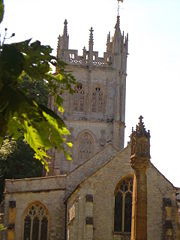 |
c. 1513 | Staple Fitzpaine Staple Fitzpaine Staple Fitzpaine is a village and civil parish in Somerset, England, situated south of Taunton in the Taunton Deane district. The village has a population of 151 and is within the Blackdown Hills Area of Outstanding Natural Beauty... 50.9588°N 3.0496°W |
Norman Norman architecture About|Romanesque architecture, primarily English|other buildings in Normandy|Architecture of Normandy.File:Durham Cathedral. Nave by James Valentine c.1890.jpg|thumb|200px|The nave of Durham Cathedral demonstrates the characteristic round arched style, though use of shallow pointed arches above the... in origin, and has a Norman doorway reset in the south aisle. The chancel dates from the 14th century. The north aisle was added and the church refenestrated in the 15th century. The tower dates from about 1500, however the south porch and vestry are much more recent dating from 1841. The crenellated 3-stage tower, has merlons pierced with trefoil headed arches set on a quatrefoil pierced parapet. St. Peter's has six bells. The oldest dates from 1480. There are four more original bells. In 1803 one of the bells was made by Thomas Castleman Bilbie of Cullompton Cullompton Cullompton is a civil parish and town in Devon, England, locally known as Cully. It is miles north-north-east of Exeter and lies on the River Culm. In 2010 it had a population of 8,639 and is growing rapidly.... , one of the Bilbie family Bilbie family The Bilbie family were bell founders and clockmakers based initially in Chew Stoke, Somerset and later at Cullompton, Devon in south-west England from the late 17th century to the early 19th century.... of bell founders and clock makers. |
West Somerset specials
(Taunton St. Mary, about 1503, but rebuilt in 1862 as an accurate copy; North PethertonNorth Petherton
North Petherton is a small town and civil parish in Somerset, England, situated on the edge of the eastern foothills of the Quantocks, and close to the edge of the Somerset Levels.The town has a population of 5,189...
, about 1508; Wellington
Wellington, Somerset
Wellington is a small industrial town in rural Somerset, England, situated south west of Taunton in the Taunton Deane district, near the border with Devon, which runs along the Blackdown Hills to the south of the town...
about 1510; and Kingsbury Episcopi
Kingsbury Episcopi
Kingsbury Episcopi is a village and civil parish on the River Parrett in Somerset, England, situated north west of Yeovil in the South Somerset district. The village has a population of 1,277. The parish includes the villages of West Lambrook, East Lambrook and Thorney.-History:The "Episcopi"...
, about 1515)
| Name of church | Photograph | Listed building grade | Year tower built | Height | Location | Description | Ref(s) |
|---|---|---|---|---|---|---|---|
| Church of St Martin Church of St Martin, Kingsbury Episcopi The Church of St Martin in Kingsbury Episcopi, Somerset, England dates from the 14th century and has been designated as a Grade I listed building.... |
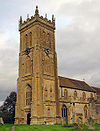 |
c. 1515 | 99 feet (30 m) | Kingsbury Episcopi Kingsbury Episcopi Kingsbury Episcopi is a village and civil parish on the River Parrett in Somerset, England, situated north west of Yeovil in the South Somerset district. The village has a population of 1,277. The parish includes the villages of West Lambrook, East Lambrook and Thorney.-History:The "Episcopi"... 50.985556°N 2.802778°W |
This tower is made of stone from nearby Ham Hill. Pevsner describes the chancel and chapels of the church as "gloriously lit" and advises visiting on a fine morning. He writes that the nave is older than the rest of the church, "no doubt of before 1400, and not yet infected with the later exuberance" of the Late Perpendicular style of the tower and other parts of St. Martin's. Poyntz Wright suggests the west tower was built in 1515. | ||
| St Mary the Virgin Church of St Mary, North Petherton The Church of St Mary in North Petherton, Somerset, England dates from the 15th century and has been designated as a grade I listed building.... |
 |
c. 1508 | 120 feet (37 m) | North Petherton North Petherton North Petherton is a small town and civil parish in Somerset, England, situated on the edge of the eastern foothills of the Quantocks, and close to the edge of the Somerset Levels.The town has a population of 5,189... 51.0922°N 3.0148°W |
This minster Minster (cathedral) Minster is an honorific title given to particular churches in England, most famously York Minster. The term minster is first found in royal foundation charters of the 7th century; and, although it corresponds to the Latin monasterium or monastery, it then designated any settlement of clergy living... church has a highly decorated tower. The building is mainly dated from the 15th century, with a minstrel Minstrel A minstrel was a medieval European bard who performed songs whose lyrics told stories of distant places or of existing or imaginary historical events. Although minstrels created their own tales, often they would memorize and embellish the works of others. Frequently they were retained by royalty... gallery from 1623, a peal of six bells Change ringing Change ringing is the art of ringing a set of tuned bells in a series of mathematical patterns called "changes". It differs from many other forms of campanology in that no attempt is made to produce a conventional melody.... , and a clock built in Bridgwater in 1807. |
||
| Church of St. Mary Magdalene St Mary Magdalene, Taunton The Church of St Mary Magdalene in Taunton, Somerset, England was completed in 1508, in Early Tudor Perpendicular Gothic style and has been designated as a Grade I listed building.-History and description:... |
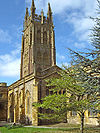 |
c. 1503 | 163 feet (50 m) | Taunton Taunton Taunton is the county town of Somerset, England. The town, including its suburbs, had an estimated population of 61,400 in 2001. It is the largest town in the shire county of Somerset.... 51.0163°N 3.1001°W |
Built of sandstone more in the South Somerset style, preserves an attractive painted interior, but its most notable aspect is its 15th and 16th century tower (rebuilt in the mid-19th century), which is one of the best examples in the country. It was described by Simon Jenkins Simon Jenkins Sir Simon David Jenkins is a British newspaper columnist and author, and since November 2008 has been chairman of the National Trust. He currently writes columns for both The Guardian and London's Evening Standard, and was previously a commentator for The Times, which he edited from 1990 to 1992... , an acknowledged authority on English churches, as “the finest in England. It makes its peace with the sky not just with a coronet but with the entire crown jewels cast in red-brown stone.” The tower itself has 12 bells and a clock mechanism. Two of the hammers on the clock mechanism are not striking. |
||
| Church of St John the Baptist Church of St John the Baptist, Wellington The Church of St John the Baptist in Wellington, Somerset, England dates from the 15th century and has been designated as a Grade I listed building.A church on the site was previously known as St. Mary the Virgin.The tower was built around 1510.... |
 |
c. 1510 | Wellington Wellington, Somerset Wellington is a small industrial town in rural Somerset, England, situated south west of Taunton in the Taunton Deane district, near the border with Devon, which runs along the Blackdown Hills to the south of the town... 50.9788°N 3.2288°W |
The 15th century church includes a monument to John Popham. |
South Somerset specials
These are some of the less elaborate towers of South Somerset: Queen CamelQueen Camel
Queen Camel is a village and civil parish, on the River Cam and the A359 road, in the South Somerset district of Somerset, England. It is about north of Yeovil. According to the 2001 census it had a population of 926. The parish includes the hamlet of Wales...
, around 1491; Mudford
Mudford
Mudford is a village and parish in Somerset, England, situated from Yeovil in the South Somerset district on the River Yeo. The village has a population of 649...
, about 1498; Kingsdon
Kingsdon, Somerset
Kingsdon is a village and parish in the South Somerset district of Somerset, England, situated south east of Somerton. The village has a population of 356.-History:...
, about 1505; Martock
Martock
Martock is a large village and civil parish in Somerset, England, situated on the edge of the Somerset Levels north west of Yeovil in the South Somerset district. The parish includes Hurst, approximately one mile south of the village, and Bower Hinton, which is located at the western end of the...
, about 1511; Chard
Chard, Somerset
Chard is a town and civil parish in the Somerset county of England. It lies on the A30 road near the Devon border, south west of Yeovil. The parish has a population of approximately 12,000 and, at an elevation of , it is the southernmost and highest town in Somerset...
1520, but possibly earlier; and Charlton Horethorne
Charlton Horethorne
Charlton Horethorne is a village and civil parish in Somerset, England, situated five miles north-east of Sherborne and five miles south-west of Wincanton in the South Somerset district...
, about 1523.
| Name of church | Photograph | Listed building grade | Year tower built | Height | Location | Description | Ref(s) |
|---|---|---|---|---|---|---|---|
| Church of St Mary the Virgin Church of St Mary the Virgin, Chard The Anglican Church of St Mary the Virgin in Chard, Somerset, England dates from the late 11th century and was rebuilt in the 15th century. It has been designated as a Grade I listed building.... |
 |
c. 1520 | Chard Chard, Somerset Chard is a town and civil parish in the Somerset county of England. It lies on the A30 road near the Devon border, south west of Yeovil. The parish has a population of approximately 12,000 and, at an elevation of , it is the southernmost and highest town in Somerset... 50.869167°N 2.963333°W |
Dates from the late 11th century and was rebuilt in the 15th century. The tower contains two bells dating from the 1790s and made by Thomas Bilbie Bilbie family The Bilbie family were bell founders and clockmakers based initially in Chew Stoke, Somerset and later at Cullompton, Devon in south-west England from the late 17th century to the early 19th century.... in Cullompton Cullompton Cullompton is a civil parish and town in Devon, England, locally known as Cully. It is miles north-north-east of Exeter and lies on the River Culm. In 2010 it had a population of 8,639 and is growing rapidly.... . The three-stage tower has moulded string courses and an angle stair turret in the north west corner. |
|||
| Church of St Barnabas Church of St Barnabas, Queen Camel The Church of St Barnabas in Queen Camel, Somerset, England was built in the 14th century and has been designated as a Grade I listed building.... |
 |
c. 1491 | Queen Camel Queen Camel Queen Camel is a village and civil parish, on the River Cam and the A359 road, in the South Somerset district of Somerset, England. It is about north of Yeovil. According to the 2001 census it had a population of 926. The parish includes the hamlet of Wales... 51.021944°N 2.573889°W |
A tall tower, built in 5 stages. | |||
| Church of All Saints Church of All Saints, Martock The Church of All Saints in Martock, Somerset, England dates from the 13th century and has been designated as a Grade I listed building.The church was acquired by the Treasurer of Wells Cathedral in 1227 and he became the rector and patron of the church.... |
 |
c. 1511 | Martock Martock Martock is a large village and civil parish in Somerset, England, situated on the edge of the Somerset Levels north west of Yeovil in the South Somerset district. The parish includes Hurst, approximately one mile south of the village, and Bower Hinton, which is located at the western end of the... 50.969444°N 2.768889°W |
Dates from the 13th century and was restored by Benjamin Ferrey Benjamin Ferrey Benjamin Ferrey, F.S.A., F.R.I.B.A. was an English architect who worked mostly in the Gothic Revival.-Family:Benjamin Ferrey was the youngest son of Benjamin Ferrey Snr, a draper who became Mayor of Christchurch. He was educated at Wimborne Grammar School.... who was Diocesan Architect to the Diocese of Bath and Wells Diocese of Bath and Wells The Diocese of Bath and Wells is a diocese in the Church of England Province of Canterbury in England.The diocese covers the county of Somerset and a small area of Dorset. The Episcopal seat of the Bishop of Bath and Wells is located in the Cathedral Church of Saint Andrew in the tiny city of... from 1841 until his death, carrying out much of the restoration work on Wells Cathedral Wells Cathedral Wells Cathedral is a Church of England cathedral in Wells, Somerset, England. It is the seat of the Bishop of Bath and Wells, who lives at the adjacent Bishop's Palace.... from 1860 onwards, and also in 1883/4 by Ewan Christian Ewan Christian Ewan Christian was a British architect. He is most notable for the restoration of Carlisle Cathedral, the alterations to Christ Church, Spitalfields in 1866, and the extension to the National Gallery that created the National Portrait Gallery. He was architect to the Ecclesiastical Commissioners... . The tower was built in four stages, to replace the previous one over the central crossing. It has offset corner buttresses to the full height of the tower. |
|||
| Church of Saint Mary Church of St Mary, Mudford The Church of St Mary in Mudford, Somerset, England dates from the 14th century and has been designated as a Grade I listed building.The church was granted by Montacute Priory to the Bishop of Bath and Wells in 1339... |
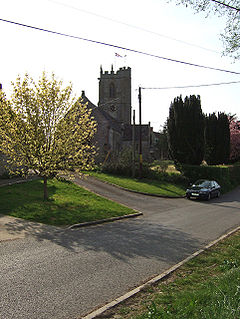 |
c. 1498 | Mudford Mudford Mudford is a village and parish in Somerset, England, situated from Yeovil in the South Somerset district on the River Yeo. The village has a population of 649... 50.976944°N 2.6075°W |
A three-stage tower divided by string courses with clasping corner buttresses, a battlemented parapet with small corner and intermediate pinnacles, and corner gargoyles. There is a stair turret on the north-east corner with a weathervane finial, and a clock face on the east side. It contains five bells dated 1582, 1621, 1623, 1664 and 1666, all by Purdue family of nearby Closworth Closworth Closworth is a village and civil parish in Somerset, England, situated five miles south of Yeovil in the South Somerset district, on the border with Dorset. The village has a population of 192.... . |
|||
| Church of St Peter and St Paul |  |
c. 1523 | Charlton Horethorne Charlton Horethorne Charlton Horethorne is a village and civil parish in Somerset, England, situated five miles north-east of Sherborne and five miles south-west of Wincanton in the South Somerset district... 51.0098°N 2.4788°W |
The 12th century acquired its two-stage tower in the late 15th century. It has offset corner buttresses almost to the full height of the tower with small crowning pinnacles. | |||
| All Saints Church |  |
c. 1505 | Kingsdon Kingsdon, Somerset Kingsdon is a village and parish in the South Somerset district of Somerset, England, situated south east of Somerton. The village has a population of 356.-History:... 51.0358°N 2.693°W |
A four-stage tower which was built in the 15th century replacing a previous one over the north transept. |
Somerset crossing towers
Perpendicular style, but built on the four arches at the intersection of the nave and chancel: AxbridgeAxbridge
Axbridge is a town in Somerset, England, situated in the Sedgemoor district on the River Axe, near the southern edge of the Mendip Hills. The town population according to the 2001 census was 2,024.-History:...
, about 1400; Wedmore
Wedmore
Wedmore is a village and civil parish in the county of Somerset, England. It is situated on raised ground, in the Somerset Levels between the River Axe and River Brue, often called the Isle of Wedmore. It forms part of Sedgemoor district...
base around 1400 and parapet about 1540; Yatton
Yatton
Yatton is a village and civil parish within the unitary authority of North Somerset, which falls within the ceremonial county of Somerset, England. It is located south-west of Bristol. Its population in 2001 was 9,176...
, around 1400; Dunster
Dunster
Dunster is a village and civil parish in west Somerset, England, situated on the Bristol Channel coast south-southeast of Minehead and northwest of Taunton. The village has a population of 862 .The village has numerous restaurants and three pubs...
, 1442; Crewkerne
Crewkerne
Crewkerne is a town in Somerset, England, situated south west of Yeovil and east of Chard in the South Somerset district close to the border with Dorset. The civil parish of West Crewkerne includes the hamlets of Woolminstone and Henley...
, about 1480; Ilminster
Ilminster
Ilminster is a country town and civil parish in the countryside of south west Somerset, England, with a population of 4,781. Bypassed a few years ago, the town now lies just east of the intersection of the A303 and the A358...
1500 to 1525.
| Name of church | Photograph | Listed building grade | Year tower built | Height | Location | Description | Ref(s) |
|---|---|---|---|---|---|---|---|
| Church of St John Church of St John the Baptist, Axbridge The Church of St John the Baptist in Axbridge, Somerset, England was built in the 13th century and has been designated as a grade I listed building.... |
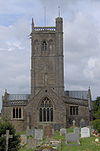 |
c. 1400 | 100 feet (30 m) | Axbridge Axbridge Axbridge is a town in Somerset, England, situated in the Sedgemoor district on the River Axe, near the southern edge of the Mendip Hills. The town population according to the 2001 census was 2,024.-History:... 51.2877°N 2.8166°W |
Church was built in the early 1400s, and grew from an earlier building dating back to about 1230. The church is built of limestone and decorated with Doulting stone, while the steps are an interesting example of Dolomitic Conglomerate (pudding stone). The elaborate crossing tower has set-back buttresses rising to pinnacles, and a parapet around the top stage pierced with quatrefoils. There are 2-light bell-chamber windows with a repeating blank window each side. On the east and west sides there are figures of St John John the Baptist John the Baptist was an itinerant preacher and a major religious figure mentioned in the Canonical gospels. He is described in the Gospel of Luke as a relative of Jesus, who led a movement of baptism at the Jordan River... and Henry VIII Henry VIII of England Henry VIII was King of England from 21 April 1509 until his death. He was Lord, and later King, of Ireland, as well as continuing the nominal claim by the English monarchs to the Kingdom of France... . It holds six bells, one of which dating from 1723 was made by Edward Bilbie Bilbie family The Bilbie family were bell founders and clockmakers based initially in Chew Stoke, Somerset and later at Cullompton, Devon in south-west England from the late 17th century to the early 19th century.... . The statue on the east side is that of St John the Baptist. On the west side is a king - perhaps Henry VII Henry VII of England Henry VII was King of England and Lord of Ireland from his seizing the crown on 22 August 1485 until his death on 21 April 1509, as the first monarch of the House of Tudor.... , which would place it after 1485. The North aisle ceiling retains some mediaeval painted panels, and amongst the carved bosses is the head of a Green Man Green Man A Green Man is a sculpture, drawing, or other representation of a face surrounded by or made from leaves. Branches or vines may sprout from the nose, mouth, nostrils or other parts of the face and these shoots may bear flowers or fruit... , with leaves sprouting around his face. The nave roof is Jacobean and dates from 1636. |
||
| Church of St Bartholomew Church of St Bartholomew, Crewkerne The Church of St Bartholomew in Crewkerne, Somerset, England dates from the 15th century and has been designated as a Grade I listed building.St Bartholomew's Parish Church stands on high ground to the west of the town... |
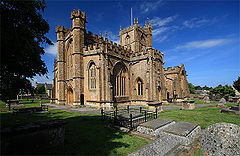 |
c. 1480 | Crewkerne Crewkerne Crewkerne is a town in Somerset, England, situated south west of Yeovil and east of Chard in the South Somerset district close to the border with Dorset. The civil parish of West Crewkerne includes the hamlets of Woolminstone and Henley... 50.881389°N 2.7925°W |
Built in the 15th and early 16th century with earlier origins. The tower is in 3 stages with string-courses between. To the south-east corner, there is a hexagonal stair turret, which is slightly taller than the tower. In 1902, the clock, commemorating the coronation of Edward VII Edward VII of the United Kingdom Edward VII was King of the United Kingdom and the British Dominions and Emperor of India from 22 January 1901 until his death in 1910... was installed replacing one made in 1802. |
|||
| Priory Church of St George Priory Church of St George, Dunster The Priory Church of St George in Dunster, Somerset, England is predominantly 15th century with evidence of 12th and 13th century work. It has been designated as a Grade I listed building.-History:... |
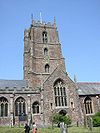 |
c. 1442 | Dunster Dunster Dunster is a village and civil parish in west Somerset, England, situated on the Bristol Channel coast south-southeast of Minehead and northwest of Taunton. The village has a population of 862 .The village has numerous restaurants and three pubs... 51.1824°N 3.4459°W |
Predominantly 15th century with evidence of 12th and 13th century work. It was restored in 1875-7 by George Edmund Street George Edmund Street George Edmund Street was an English architect, born at Woodford in Essex.- Life :Street was the third son of Thomas Street, solicitor, by his second wife, Mary Anne Millington. George went to school at Mitcham in about 1830, and later to the Camberwell collegiate school, which he left in 1839... . The church has a cruciform plan with a central 4-stage tower, built in 1443 with diagonal buttresses, a stair turret and single bell-chamber windows. |
|||
| Church of St Mary Church of St Mary, Ilminster The Church of St Mary in Ilminster, Somerset, England dates from the 15th century and has been designated as a Grade I listed building.Ilminster takes its name from the River Isle and its large church of St Mary, which is known as The Minster. The 15th century Hamstone building was refurbished in... |
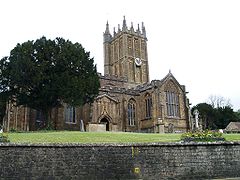 |
Between 1500 and 1525 | Ilminster Ilminster Ilminster is a country town and civil parish in the countryside of south west Somerset, England, with a population of 4,781. Bypassed a few years ago, the town now lies just east of the intersection of the A303 and the A358... 50.927222°N 2.911389°W |
The large church, which is known as The Minster. The Hamstone Hamstone Hamstone is the colloquial name given to stone from Ham Hill, Somerset, England. Hamstone is a Jurassic limestone from the Toarcian, or Upper Lias, stage. It is a well cemented medium to coarse grained limestone characterised by its honey-gold colour and marked bedding planes. The stone contains... building dates from the 15th century, but was refurbished in 1825 by William Burgess and the chancel restored 1883. The tower rises two storeys above the nave. It has three bays, with a stair turret to the north-west corner. The bays are articulated by slender buttresses with crocketed finials above the castellated parapet. Each bay on both stages contains a tall 2-light mullioned-and-transomed window with tracery. The lights to the top are filled with pierced stone-work, those to the base are solid. The stair turret has string courses coinciding with those on the tower, and a spirelet with a weathervane. The tower contains a bell dating from 1732 and made by Thomas Bilbie and another from 1790 made by William Biblie of the Bilbie family Bilbie family The Bilbie family were bell founders and clockmakers based initially in Chew Stoke, Somerset and later at Cullompton, Devon in south-west England from the late 17th century to the early 19th century.... . |
|||
| Church of St Mary Church of St Mary, Wedmore The Church of St Mary in Wedmore, Somerset, England is predominantly from the 15th century, although some 12th and 13th century work survives. It has been designated as a Grade I listed building.... |
 |
c. 1400 | Wedmore Wedmore Wedmore is a village and civil parish in the county of Somerset, England. It is situated on raised ground, in the Somerset Levels between the River Axe and River Brue, often called the Isle of Wedmore. It forms part of Sedgemoor district... 51.2277°N 2.811°W |
Predominantly from the 15th century, although some 12th and 13th century work survives. The tower with its set back buttresses, includes triple 2-light bell chamber windows, those to centre are louvred, those to each side blank. | |||
| Church of St Mary Church of St Mary, Yatton The Church of St Mary in central Yatton, Somerset, England is often called the 'Cathedral of the Moors' due to its size and grandeur in relation to the village... |
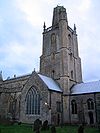 |
c. 1400 | Yatton Yatton Yatton is a village and civil parish within the unitary authority of North Somerset, which falls within the ceremonial county of Somerset, England. It is located south-west of Bristol. Its population in 2001 was 9,176... 51.385°N 2.8185°W |
Often called the 'Cathedral of the Moors' due to its size and grandeur in relation to the village. While the current church was constructed in the 14th century, it is likely that a previous Christian Christian A Christian is a person who adheres to Christianity, an Abrahamic, monotheistic religion based on the life and teachings of Jesus of Nazareth as recorded in the Canonical gospels and the letters of the New Testament... church was located on the same site. The tower has three stages with diagonal weathered buttresses with crocketed pinnacles. There is a south east hexagonal stair turret rising above the parapet with panelled sides to the top, and an open cusped parapet. |
Other Somerset towers
Poyntz Wright also uses his systematics to date some small towers: Nempnett ThrubwellNempnett Thrubwell
Nempnett Thrubwell is a small village and civil parish in dairying country on the western edge of Bath and North East Somerset, in the county of Somerset, England. It is about 15 km south-west of Bristol. The parish, which has a population of 189, is sheltered by the Mendip Hills, near the River...
at around 1468; Chew Stoke
Chew Stoke
Chew Stoke is a small village and civil parish in the Chew Valley, in Somerset, England, about south of Bristol. It is at the northern edge of the Mendip Hills, a region designated by the United Kingdom as an Area of Outstanding Natural Beauty, and is within the Bristol/Bath green belt...
about 1475; West Pennard
West Pennard
West Pennard is a village and civil parish east of Glastonbury in the Mendip district of Somerset, England. The parish includes the hamlets of Coxbridge and Woodlands.-History:...
at about 1482; Charlton Musgrove
Charlton Musgrove
Charlton Musgrove is a village and civil parish in Somerset, England, situated north east of Wincanton in the South Somerset district. The village has a population of 375...
at perhaps around 1490; Pylle
Pylle
Pylle is a village and civil parish south west of Shepton Mallet, and from Wells, in the Mendip district of Somerset, England. It has a population of 176...
at about 1497; Cloford after 1500. He also pegs three of the smaller towers in the western part of Somerset: Combe Florey
Combe Florey
Combe Florey is a village and civil parish in Somerset, England, situated north west of Taunton in the Taunton Deane district, on the West Somerset Railway. The village has a population of 252...
about 1499; Fivehead
Fivehead
Fivehead is a village and civil parish in Somerset, England, situated on the Fivehead River, miles east of Taunton in the South Somerset district...
, around 1505; and Langford Budville
Langford Budville
Langford Budville is a village and civil parish in Somerset, England, situated near the River Tone miles north-west of Wellington, from Wiveliscombe and west of Taunton in the Taunton Deane district. The parish includes the hamlets of Bindon, Lower Chipley, Lower Wellisford, Ramsey and Runnington...
, 1509. The end of the Perpendicular period in architecture coincides with construction of Ruishton
Ruishton
Ruishton is a village and civil parish in Somerset, England, situated on the River Tone and A358 road east of Taunton in the Taunton Deane district. The village has a population of 1,389...
, 1533; Chedzoy
Chedzoy
Chedzoy is a civil parish village east of Bridgwater in the Sedgemoor district of Somerset, England.-History:The village is at the western end of King's Sedgemoor and lies on an 'island' of Burtle marine sands, close to King's Sedgemoor Drain. The area was settled possibly in the Mesolithic...
, 1539; and Batcombe
Batcombe, Somerset
Batcombe is a village and civil parish in the Mendip District of Somerset, England, situated in the steep valley of the River Alham five miles south-east of Shepton Mallet. The parish has a population of 379...
and Chewton Mendip
Chewton Mendip
Chewton Mendip is a village and civil parish in the Mendip District of Somerset, England. It is situated north of Wells, south of Bristol on the Mendip Hills and is the source of the River Chew. The parish includes the hamlet of Bathway.- History :...
, around 1540.
| Name of church | Photograph | Listed building grade | Year tower built | Height | Location | Description | Ref(s) |
|---|---|---|---|---|---|---|---|
| Church of St. Mary the Virgin Church of St Mary the Virgin, Batcombe The Church of St Mary the Virgin in Batcombe, Somerset, England dates from the 15th and 16th centuries and was restored in the 19th. It has been designated by English Heritage as a Grade I listed building.... |
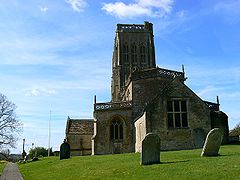 |
c. 1543 | Batcombe Batcombe, Somerset Batcombe is a village and civil parish in the Mendip District of Somerset, England, situated in the steep valley of the River Alham five miles south-east of Shepton Mallet. The parish has a population of 379... 51.1493°N 2.4439°W |
Dates from the 15th and 16th centuries and was restored in the 19th. The tower contains five bells dating from 1760 and made by Thomas Bilbie Bilbie family The Bilbie family were bell founders and clockmakers based initially in Chew Stoke, Somerset and later at Cullompton, Devon in south-west England from the late 17th century to the early 19th century.... in Cullompton Cullompton Cullompton is a civil parish and town in Devon, England, locally known as Cully. It is miles north-north-east of Exeter and lies on the River Culm. In 2010 it had a population of 8,639 and is growing rapidly.... . |
|||
| Church of St Mary Church of St Mary, Chedzoy The Anglican Church of St Mary in Chedzoy, Somerset, England dates from the 13th century and has been designated as a grade I listed building.... |
 |
c. 1539 | Chedzoy Chedzoy Chedzoy is a civil parish village east of Bridgwater in the Sedgemoor district of Somerset, England.-History:The village is at the western end of King's Sedgemoor and lies on an 'island' of Burtle marine sands, close to King's Sedgemoor Drain. The area was settled possibly in the Mesolithic... 51.1345°N 2.9429°W |
Dates from the 13th century. It still bears marks form the forces of The Duke of Monmouth James Scott, 1st Duke of Monmouth James Scott, 1st Duke of Monmouth, 1st Duke of Buccleuch, KG, PC , was an English nobleman. Originally called James Crofts or James Fitzroy, he was born in Rotterdam in the Netherlands, the eldest illegitimate son of Charles II and his mistress, Lucy Walter... during the Monmouth Rebellion Monmouth Rebellion The Monmouth Rebellion,The Revolt of the West or The West Country rebellion of 1685, was an attempt to overthrow James II, who had become King of England, King of Scots and King of Ireland at the death of his elder brother Charles II on 6 February 1685. James II was a Roman Catholic, and some... who sharpened their swords before battle. |
|||
| Church of St Mary Magdalene Church of St Mary Magdalene, Chewton Mendip The Church of St Mary Magdalene in Chewton Mendip, Somerset, was built in the 1540s and has been designated as a Grade I listed building.-History:... |
c. 1540 | 126 feet (38 m) | Chewton Mendip Chewton Mendip Chewton Mendip is a village and civil parish in the Mendip District of Somerset, England. It is situated north of Wells, south of Bristol on the Mendip Hills and is the source of the River Chew. The parish includes the hamlet of Bathway.- History :... 51.2761°N 2.5799°W |
Made of Lias Stone, with a tower of Doulting Stone which was "unfinished" in 1541. The tower contains a bell dating from 1753 and made by Thomas Bilbie. In addition, there is a peal of eight bells by Taylor's of Loughborough. The church, which was started in 1441 by Carthusian monks, incorporates several Norman Norman architecture About|Romanesque architecture, primarily English|other buildings in Normandy|Architecture of Normandy.File:Durham Cathedral. Nave by James Valentine c.1890.jpg|thumb|200px|The nave of Durham Cathedral demonstrates the characteristic round arched style, though use of shallow pointed arches above the... features including the north doorway. The register commences in the year 560. Near the altar is a stone seat, known as a 'frid' for those, especially criminals, who took sanctuary in the church. The church includes monuments to Sir Henry Fitzroger and his wife who died in 1388 and Frances Lady Waldegrave 1879. The Waldegrave family have owned Chewton from 1553, but did not live in the village until the 1860s. Wade and Wade in their 1929 book Somerset described the church as a "singularly interesting church, which possesses one of the most stately towers in the county". |
|||
| Church of St Martin Church of St Martin, Fivehead The Church of St Martin in Fivehead, Somerset, England dates from the 13th century and has been designated as a Grade I listed building.The tower dates from around 1505.-See also:* List of Grade I listed buildings in South Somerset... |
 |
c. 1505 | Fivehead Fivehead Fivehead is a village and civil parish in Somerset, England, situated on the Fivehead River, miles east of Taunton in the South Somerset district... 51.001667°N 2.922778°W |
Dates from the 13th century | |||
| Church of St Peter Church of St. Peter, Langford Budville The Church of St. Peter in Langford Budville, Somerset, England dates from the 15th century and has been designated as a Grade I listed building.... |
c. 1510 | Langford Budville Langford Budville Langford Budville is a village and civil parish in Somerset, England, situated near the River Tone miles north-west of Wellington, from Wiveliscombe and west of Taunton in the Taunton Deane district. The parish includes the hamlets of Bindon, Lower Chipley, Lower Wellisford, Ramsey and Runnington... 50.9988°N 3.2669°W |
Dates from the 15th century. | ||||
| Church of St Nicholas Church of St Nicholas, West Pennard The Church of St Nicholas in West Pennard, Somerset, England dates from the 15th century and is a Grade I listed building.From the 13th to 15th century West Pennard was a chapelry of the Church of St John the Baptist in Glastonbury... |
 |
c. 1482 | West Pennard West Pennard West Pennard is a village and civil parish east of Glastonbury in the Mendip district of Somerset, England. The parish includes the hamlets of Coxbridge and Woodlands.-History:... 51.1412°N 2.6397°W |
Dates from the 15th century. | |||
| St Andrews Church | 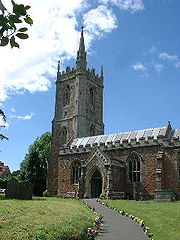 |
c. 1475 | Chew Stoke Chew Stoke Chew Stoke is a small village and civil parish in the Chew Valley, in Somerset, England, about south of Bristol. It is at the northern edge of the Mendip Hills, a region designated by the United Kingdom as an Area of Outstanding Natural Beauty, and is within the Bristol/Bath green belt... 51.3507°N 2.6383°W |
Constructed in the 15th century and underwent extensive renovation in 1862. The inside of the church is decorated with 156 angels in wood and stone, and the church includes a tower with an unusual spirelet on the staircase turret. In the tower hang bells Church bell A church bell is a bell which is rung in a church either to signify the hour or the time for worshippers to go to church, perhaps to attend a wedding, funeral, or other service... cast by the Bilbie family Bilbie family The Bilbie family were bell founders and clockmakers based initially in Chew Stoke, Somerset and later at Cullompton, Devon in south-west England from the late 17th century to the early 19th century.... who lived and worked in the village. |
|||
| Church of St Mary Church of St Mary, Nempnett Thrubwell The Anglican Church of St Mary stands on Knap Hill in Nempnett Thrubwell, Somerset, England dates from the 15th century, but was built on the site of an earlier Norman church. It is a Grade II* listed building,... |
c. 1468 | Nempnett Thrubwell Nempnett Thrubwell Nempnett Thrubwell is a small village and civil parish in dairying country on the western edge of Bath and North East Somerset, in the county of Somerset, England. It is about 15 km south-west of Bristol. The parish, which has a population of 189, is sheltered by the Mendip Hills, near the River... 51.3379°N 2.6798°W |
A tower containing five bells. The tower has set back buttresses and two arch bell openings with tracery. The tower is crowned by a parapet with blank arcading, and square pinnacles, it also has a slightly higher stair turret Turret In architecture, a turret is a small tower that projects vertically from the wall of a building such as a medieval castle. Turrets were used to provide a projecting defensive position allowing covering fire to the adjacent wall in the days of military fortification... . The late Victorian chancel of 1897 is in the decorated style. Inside the church is a screen attributed to Pugin Pugin Pugin most commonly refers to Augustus Welby Northmore Pugin , English architect and designer.Other members of his family include:... , although Pevsner Nikolaus Pevsner Sir Nikolaus Bernhard Leon Pevsner, CBE, FBA was a German-born British scholar of history of art and, especially, of history of architecture... is of the opinion the architect is probably Pugin the younger Augustus Pugin Augustus Welby Northmore Pugin was an English architect, designer, and theorist of design, now best remembered for his work in the Gothic Revival style, particularly churches and the Palace of Westminster. Pugin was the father of E. W... . |
||||
| Church of St Mary |  |
c. 1505 | Cloford 51.1944°N 2.3929°W |
Norman Norman architecture About|Romanesque architecture, primarily English|other buildings in Normandy|Architecture of Normandy.File:Durham Cathedral. Nave by James Valentine c.1890.jpg|thumb|200px|The nave of Durham Cathedral demonstrates the characteristic round arched style, though use of shallow pointed arches above the... church dates from the 15th century and was rebuilt in 1856. |
|||
| Church of St Thomas |  |
c. 1497 | Pylle Pylle Pylle is a village and civil parish south west of Shepton Mallet, and from Wells, in the Mendip district of Somerset, England. It has a population of 176... 51.1443°N 2.564°W |
Rebuilt in 1868 for the Portman family, but a 15th century tower from the earlier church remains. |

